机械论文的外文参考文献1
机械类方向的论文参考文献

机械类方向的论文参考文献机械类方向的论文参考文献在日常学习和工作中,大家最不陌生的就是论文了吧,通过论文写作可以培养我们的科学研究能力。
那么你知道一篇好的论文该怎么写吗?下面是小编为大家收集的机械类方向的论文参考文献,希望对大家有所帮助。
机械类论文参考文献1 [1] 王遐.随车起重机行业扫描[J].工程机械与维修,2006(3):68-71 [2] 王金诺,于兰峰.起重运输机金属结构[M].北京:中国铁道出版社,2002 [3] 卢章平,张艳.不同有限元分析网格的.转化[J].机械设计与研究,2009(6):10-14 [4] 朱秀娟.有限元分析网格划分的关键技巧[J].机械工程与自动化,2009(1):185-186 [5] 姚卫星.结构疲劳寿命分析[M].北京:国防工业出版社,2003.50-54 [6] 桥斌.国内外随车起重机的对比[J].工程机械与维修,2006(7):91-92 [7] 王欣,黄琳.起重机伸缩臂截面拓扑优化[J].大连理工大学学报,2009(3):374-379 机械类论文参考文献2 1 金会庆.驾驶适性.合肥:安徽人民出版社,1995. 2 蔡辉、张颖、倪宗瓒等.Delphi法中评价专家的筛选.中国卫生事业管理,1995,1:49~55. 3 侯定丕.管理科学定量分析引论.合肥:中国科技大学出版社,1993. 4 王有森.德尔菲法. 医学科研管理学(刘海林主编.第一版),北京:人民卫生出版社,1991:279~289. 5 安徽省劳动保护教育中心编.劳动安全、卫生国家标准及其编制说明汇编第三辑,1987. 6 Kaoru Ishikawa. Guide to Quality Control. Asian Productivity Organization.Tokyo. 1982:42~49 机械类论文参考文献3 [1]郑文纬,吴克坚 .机械原理[M] .北京:高等教育出版社,1997 [2]濮良贵.纪名刚.机械设计[M] .北京:高等机械出版社.2006 [3]杨家军.机械系统创新设计[M] .武汉:华中科技大学出版社.2000 [4]高志.黄纯颖. 机械创新设计[M] . 北京:高等机械出版社.2010 [5]王晶.第四届全国大学生机械创新设计大赛决赛作品选集. 北京:高等教育出版社,2011 [6]黄华梁、彭文生.创新思维与创造性技法. 北京:高等教育出版社,2007 [7]李学志.计算机辅助设计与绘图[M] .北京:清华大学出版社.2007 [8]吴宗泽.机械设计手册[M] .北京:机械工业出版社.2008 [9]颜鸿森.姚燕安.王玉新等译.机构装置的创造性设计(creative design of mechanical devices)[M] .北京:机械工业出版社.2002 [10]邹慧君.机械运动方案设计手册[M] .上海:上海交通大学出版社.1994 [11]王世刚.张春宜.徐起贺.机械设计实践[M] .哈尔滨:哈尔滨工程大学出版社.2001 [12][美]厄儿德曼.桑多尔著.机构设计——分析与综合.第一卷(1992),第二卷(1993).庄细荣等译.北京:高等教育出版社.1994 [13]温建民. Pro/E wildfire5.0 三维设计基础与工程范例[M] .清华大学出版社.2008[14]赵瑜.闫宏伟.履带式行走机构设计分析与研究[M] .东北大学出版社.2011[15]秦大同.谢里阳.现代机械设计手册.第三卷.化学工业出版社[M] .2011 [16]闻邦椿.机械设计手册.第二卷.第三卷.第四卷.机械工业出版社.2011 [17]陈敏.缪终生一种新型滚动四杆螺母副的研究与应用[J] .江西理工大学南昌校区.江西.南昌 2009. [18]彭国勋.肖正扬.自动机械的凸轮机构设计[M] .机械工业出版社.1990 [19]孙志礼.机械设计[M] .东北大学出版.2011 [20]张也影.流体力学[M] .高等教育出版社.1998 [21]吴涛、李德杰,彭城职业大学学报,虚拟装配技术,[J] 2001,16(2):99-102. [22]叶修梓、陈超祥,ProE基础教程:零件与装配体[M] ,机械工业出版社,2007. [23]邓星钟,机电传动控制[M] ,华中科技大学出版社,2001. [24]朱龙根,简明机械零件设计手册[M] ,机械工业出版社,2005. [25]李运华,机电控制[M].北京航空航天大学出版社,2003. 机械类论文参考文献4 [1] 邹银辉.煤岩体声发射传播机理研究[D].山东:山东科技大学硕士论文,2007 [2] 贾宝新,李国臻.矿山地震监测台站的空间分布研究与应用[J].煤炭学报,2010,35(12):2045-2048 [3] 柳云龙,田有,冯晅,等.微震技术与应用研究综述[J].地球物理学进展,2013,28(4):1801-1808 [4] 徐剑平,陈清礼,刘波,等.微震监测技术在油田中的应用[J].新疆石油天然气,2011,7(1):89-82 [5] 汪向阳,陈世利.基于地震波的油气管道安全监测[J].电子测量技术, 2008, 31(7): 121-123 [6] 何平.地铁运营对环境的振动影响研究[D].北京:北京交通大学,2012 [7] 陆基孟.地震勘探原理[M].山东:中国石油大学出版社,1990 [8] 崔自治.土力学[M].北京:中国电力出版社,2010 [9] 许红杰,夏永学,蓝航 ,等.微震活动规律及其煤矿开采中的应用 [J]. 煤矿开采,2012,17(2):93-95、16 [10] 李铁,张建伟,吕毓国,等.采掘活动与矿震关系[J].煤炭学报,2011,36(12):2127-2132 [11] 陈颙.岩石物理学[M].北京:北京大学出版社,2001 [12] 秦树人,季忠,尹爱军.工程信号处理[M].北京:高等教育出版社,2008 [13] 董越. SF6 高压断路器在线监测及振动信号的分析[D].上海:上海交通大学,2008 [14] 张谦.基于地脉动观测的城市地区工程场地动参数及反演地下结构的研究[D].北京:北京交通大学,2012 [15] 刘振武,撒利明,巫芙蓉,等.中国石油集团非常规油气微地震监测技术现状及发展方向[J].石油地球物理勘探,2013,48(5):843-853 [16] 聂伟荣.多传感器探测与控制网络技术-地面运动目标震动信号探测与识别[D].南京:南京理工大学,2001(6). [17] T. Damarla and D. Ufford,Personnel detection using ground sensors[J].Proc. of SPIE, Orlando,FL, 2007, vol. 656205, 1-10.。
论文的参考文献

论⽂的参考⽂献参考⽂献是在学术研究过程中,对某⼀著作或论⽂的整体的参考或借鉴。
征引过的⽂献在注释中已注明,不再出现于⽂后参考⽂献中。
按照字⾯的意思,参考⽂献是⽂章或著作等写作过程中参考过的⽂献。
论⽂的参考⽂献1 参考⽂献: [1]Ronald WRebore. Human Resources Administration in Education(6th Edition)[M]. Boston:Allyn &Bacon,Pearson Education, Inc.,20xx [2]C Chadwick, P Cappelli. Alternative to Generic Strategy Typologies in Strategic Human Resource Management[M]. Greenwich, Ct: JAI Press, 1999 [3]宋本江胡跃福:⼈才招聘,另请⾼明还是⾃⼰培养[J].中国⼈才,20xx(8) [4]丁敬平:向跨国公司学习什么[J].中国企业家,20xx(11) [5]程桢贾雅军:企业内部⼈才资源的运⽤[J].经济问题,20xx(11) [6]安鸿章:企业⼈才聘任的两种模式[J].中国⼈才,20xx(4) [1]亚瑟W⼩舍曼:乔治W勃兰德·斯科特A斯奈尔著张⽂贤主译:⼈⼒资源管理.东北财经⼤学出版社,20xx [2]魏峰李赕张⽂贤:国内外⼼理契约研究的新进展.管理科学学报,20xx(10) [3]陈加洲:凌⽂辁&⽅俐洛.组织中的⼼理契约,管理科学学报, 20xx,4(2) [4]陈加洲凌⽂辁·⽅俐洛:企业员⼯⼼理契约的结构维度. ⼼理学报, 20xx,35(3) 参考⽂献: [1]王刚编著:《把握好⽤⼈的技巧与管⼈的学问》.地震出版社,20xx年2⽉ [2]斯蒂芬·P·罗宾斯著:《管⼈的真理》.中信出版社,20xx年9⽉ [3]李诚主编:《⼈⼒资源管理的12堂课》.中信出版社,20xx年11⽉ [4]吴志明著:《员⼯招聘与选拔实务⼿册.机械⼯业出版社,20xx年1⽉ [5]赵曙明:《⼈⼒资源管理研究》.中国⼈民⼤学出版社,20xx年 [6]詹姆斯.W.沃克:《⼈⼒资源战略》.中国⼈民⼤学出版社,20xx年1⽉ [7]罗布.⼽菲:《⼈员管理》.中国⼈民⼤学出版社,20xx年01⽉论⽂的参考⽂献2 [1]林红梅.“⽣态⽂明与和谐社会”理论研讨会综述[J].思想理论教育导刊,20xx(5):92-93. [2]杨多贵,周志⽥,陈劭锋.我国⼈与⾃然和谐发展⾯临的挑战及其战略选择[J].上海经济研究,20xx(4):6-12. [3]利奥波德.沙乡年鉴[M].侯⽂惠,译,长春:吉林⼈民出版社, 20xx. [4]卢风,肖葳.应⽤伦理学导论[M].北京:清华⼤学出版社, 20xx. [5]李培超.⾃然的伦理尊严[M].南昌:江西⼈民出版社,20xx:16. [6]林红梅.试论拯救环境危机的多维视⾓[J].⾏政与法,20xx(1):97-99. [7]马克思,恩格斯.马克思恩格斯全集:第25卷[M].北京:⼈民出版社,1971:119. [8]马克思,恩格斯.马克思恩格斯全集:第20卷[M].北京:⼈民出版社,1971:519. [9]何怀宏.⽣态伦理——精神资源与哲学基础[M].保定:河北⼤学出版社,20xx:15.(责任编辑:1011)论⽂的参考⽂献3 学术研究应精确、有据、坦诚、创新和积累。
机械外文文献及翻译
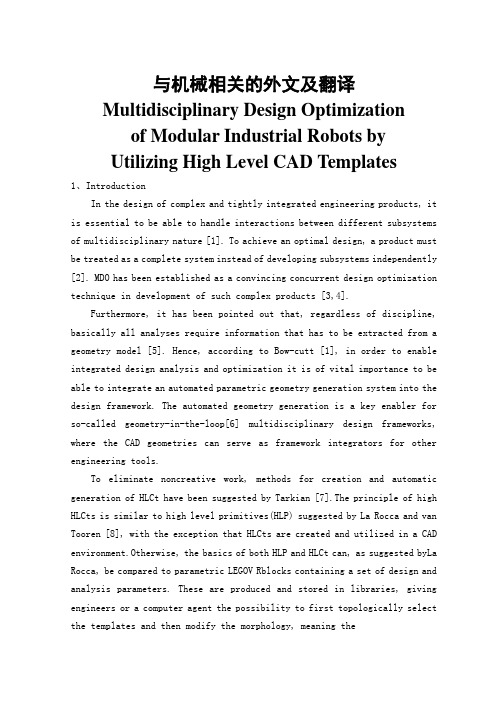
与机械相关的外文及翻译Multidisciplinary Design Optimization of Modular Industrial Robots by Utilizing High Level CAD Templates1、IntroductionIn the design of complex and tightly integrated engineering products, it is essential to be able to handle interactions between different subsystems of multidisciplinary nature [1]. To achieve an optimal design, a product must be treated as a complete system instead of developing subsystems independently [2]. MDO has been established as a convincing concurrent design optimization technique in development of such complex products [3,4].Furthermore, it has been pointed out that, regardless of discipline, basically all analyses require information that has to be extracted from a geometry model [5]. Hence, according to Bow-cutt [1], in order to enable integrated design analysis and optimization it is of vital importance to be able to integrate an automated parametric geometry generation system into the design framework. The automated geometry generation is a key enabler for so-called geometry-in-the-loop[6] multidisciplinary design frameworks, where the CAD geometries can serve as framework integrators for other engineering tools.To eliminate noncreative work, methods for creation and automatic generation of HLCt have been suggested by Tarkian [7].The principle of high HLCts is similar to high level primitives(HLP) suggested by La Rocca and van Tooren [8], with the exception that HLCts are created and utilized in a CAD environment.Otherwise, the basics of both HLP and HLCt can, as suggested byLa Rocca, be compared to parametric LEGOV Rblocks containing a set of design and analysis parameters. These are produced and stored in libraries, giving engineers or a computer agent the possibility to first topologically select the templates and then modify the morphology, meaning theshape,of each template parametrically.2、Multidisciplinary Design FrameworkMDO is a “systematic approach to design space exploration”[17], the implementation of which allows the designer to map the interdisciplinary relations that exist in a system. In this work, the MDO framework consists of a geometry model, a finite element(FE) model, a dynamic model and a basic cost model. The geometry model provides the analysis tools with geometric input. The dynamic model requires mass properties such as mass, center of gravity, and inertia. The FE model needs the meshed geometry of the robot as well as the force and torque interactions based on results of dynamic simulations.High fidelity models require an extensive evaluation time which has be taken into account. This shortcoming is addressed by applying surrogate models for the FE and the CAD models. The models are briefly presented below. 2.1 High Level CAD Template—Geometry ModelTraditionally, parametric CAD is mainly focused on morphological modifications of the geometry. However, there is a limit to morphological parameterization as follows:•The geometries cannot be radically modified.•Increased geometric complexity greatly increases parameterization complexity.The geometry model of the robot is generated with presaved HLCts, created in CATIA V5. These are topologically instantiated with unique internal design variables. Topological parameterization allows deletion, modification, and addition of geometricelements which leads to a much greater design space captured.Three types of HLCts are used to define the industrial robot topologically; Datum HLCt which includes wireframe references required for placement for the Actuator HLCTs and Structure HLCts, as seen Fig.2.Fig. 2 An industrial robot (left) and a modular industrial robot(right) The names of the references that must be provided for each HLCt instantiation are stored in the knowledge base (see Appen-dix A.4), which is searched through by the inference engine. In Appendix A, pseudocode examples describes how the references are retrieved and how they are stored in the knowledge base.The process starts by the user defining the number of degrees of freedom (DOF) of the robot (see Fig. 3) and is repeated until the number of axis (i) is equal to the user defined DOF.In order to instantiate the first Structure HLCt, two Datum and two actuator instances are needed. References from the two Datum instances help orienting the structure in space, while the geometries of the actuator instances, at both ends of the link, are used to construct the actuator attachments, as seen in Figs. 2 and 3. For the remaining links, only one new instance of both datum and actuator HLCts are required, since the datum and actuator instances from adjacent links are already available.Appendix A.2 shows a pseudocode example of an instantiation function. The first instantiated datum HLCt is defined with reference to the absolute coordinate system. The remaining datum HLCt instances are placed in a sequential order, where the coordinate system of previous instances is used as reference for defining the position in space according to user inputs (see also AppendixA.3). Furthermore, the type of each actuator and structure instance is user defined.Fig. 3 The high level CAD template instantiation process Since it is possible to create new HLCts in the utilized CAD tool, the users are not forced to merely choose from the templates available. New HLCts can be created, placed in the database and parametrically inserted into the models.2.2 Dynamic ModelThe objective of performing dynamic simulation of a robot is to evaluate system performance, such as predicting acceleration and time performance, but it also yields loads on each actuated axis, needed for actuator lifetime calculations and subsequent stress analysis based on FE calculations. Thedynamic model in the outlined framework is developed in Modelica using Dymola, and it constitutes a seven-axis robot arm based on the Modelica Standard library [18].The dynamic model receives input from the geometry model,as well as providing output to the FE model, which is further described in Sec. 2.3. However, to better understand the couplings between the models, the Newton –Euler formulation will be briefly discussed. In this formulation, the link velocities and acceleration are iteratively computed, forward recursivelyWhen the kinematic properties are computed, the force and torque interactions between the links are computed backward recursively from the last to the first link2.3 FE Surrogate ModelTo compute the structural strength of the robot, FE models for each robot link is created utilizing CATIA V5, see Fig. 4. For each HLCt, mesh and boundary conditions are manually preprocessed in order to allow for subsequent automation for FE-model creation. The time spent on preprocessing each FE-model is thus extensive. Nonetheless, the obtained parametric FE-model paves way for automated evaluation of a wide span of concepts. Each robot link is evaluated separately with the load conditions extracted from the dynamicmodel. The force (fi-11and fi) and torque (ţi-1and ti) are applied on the surfaceswhere the actuators are attached.2.4 Geometric Surrogate Models.Surrogate models are numerically efficient models to determine the relation between inputs and o utputs of a model [19]. The input variables for the proposed application are the morphological variables thickness and link height as well as a topological variable actuator type. The outputs of the surrogate models are mass m, Inertia I, and center of gravity ri,ci.To identify the most suitable type of surrogate model for the outlined problem, a range of surrogate models types are created and evaluated using 50 samples. The precision of each surrogate model is compared with the values of the original model with 20 new samples. The comparison is made using the relative average absolute error (RAAE) and relative maximum absolute error (RMAE) as specified by Shan et al. [20], as well as the normalized root mean square error (NRMSE), calculated as seen in Eq. (3). All precision metrics are desired to be as low as possible, since low values mean that the surrogate model is accurateThe resulting precision metrics can be seen in Appendix B and the general conclusion is that anisotropic kriging [21], neural networks [22], and radialbasis functions [23] are the most promising surrogate models. To investigate the impact of increasing number of samples, additional surrogate models of those three are fitted using 100 samples, and the results compiled in Appendix B. The resulting NRMSEs for 50 and 100 samples for anistotropic kriging, neural networks, and radial basis functions can be seen in Fig.5. The figures inside the parentheses indicate the number of samples used to fit the surrogate models.Fig. 5 Graph of the NRMSEs for different surrogate models,fitted using 50 and 100 samplesAccording to Fig. 5, anisotropic kriging outperforms the other surrogate models and the doubling of the number of samples usedfor fitting the surrogate model increases the precision dramatically.2.5 FE Surrogate ModelsFor generating FE surrogate models, the anisotropic kriging was also proven to be the most accurate compared to the methods evaluated in Sec. 2.4. Here, one surrogate model is created for each link. Inputs are thickness,actuators, force (fi-11and fi) and torque (ţi-1and ti). The output for eachsurrogate model is maximum stress (MS).A mean error of approximately 9% is reached when running 1400 samples for each link. The reason for the vast number of samples, compared to geometry surrogate models, has to do with a much larger design space.利用高水平CAD模板进行模块化工业机器人的多学科设计优化1 介绍指出,除了规则,基本上所有的分析都需要信息,而这些信息需要从一个几何模型中提取。
机械自动化论文参考文献

机械自动化论文参考文献文后参考文献的著录是被著录的文献本身。
专著、连续出版物等可依次按题名页、封面、刊头等著录。
缩微制品、录音制品等非书资料可依据题名帧、片头、容器上的标签、附件等著录。
下面是和大家分享的机械自动化论文参考文献,更多内容请关注(.oh100./bylw)。
篇一:参考文献[1]王飞,刘洪才,潘立冬.分层式结构变电站自动化通信系统研究综述[J].华北电力大学学报(自然科学版).xx(01)[2]周文瑜,温刚,王钇,苏迪.SCL在变电站自动化系统的应用[J].继电器.xx(15)[3]郭嘉,韩力,罗建,高仕红.SCL在变电站智能电子装置通信配置中的应用[J].重庆大学学报(自然科学版).xx(12)[4]谢志迅,邓素碧,臧德扬.数字化变电站通信网络冗余技术[J].电力自动化设备.xx(09)[5]刘洋,罗毅,易秀成,涂光瑜,陈维莉,江伟.变电站综合自动化系统的软件可靠性研究[J].继电器.xx(18)[6]唐富华,郭银景,杨阳.基于IEC61850和嵌入式以太网的变电站网络通信系统[J].电气自动化.xx(03)[7]李俊刚,宋小会,狄军峰,魏勇.基于IEC62439-3的智能变电站通信网络冗余设计[J].电力系统自动化.xx(10)[8]王凤祥,方春恩,李伟.基于IEC61850的SCL配置研究与工具开发[J].电力系统保护与控制.xx(10)[9]于敏,何正友,钱清泉.基于Markov过程的硬/软件综合系统可靠性分析[J].电子学报.xx(02)[10]窦晓波,胡敏强,吴在军,杜炎森,闵涛.数字化变电站通信网络的组建与冗余方案[J].电力自动化设备.xx(01)[11]唐富华,郭银景,杨阳.基于IEC61850和嵌入式以太网的变电站网络通信系统[J].电气自动化.xx(03)[12]张沛超,高翔.全数字化保护系统的可靠性及元件重要度分析[J].中国电机工程学报.xx(01)[13]许铁峰,徐习东.高可用性无缝环网在数字化变电站通信网络的应用[J].电力自动化设备.xx(10)[14]童晓阳,廖晨淞,周立龙,李映川,章力,王晓茹,许克崃.基于IEC61850-9-2的变电站通信网络仿真[J].电力系统自动化.xx(02)[15]王丽华,马君华,王传启,马长武,江涛,韩明峰,王志华,张丽胜,种惠敏.变电站配置描述语言SCL的应用研究[J].电网技术.xx(S1)[16]陈原子,徐习东.基于并行冗余网络的数字化变电站通信网络构架[J].电力自动化设备.xx(01)[17]方晓洁,季夏轶,卢志刚.基于OPNET的数字化变电站继电保护通信网络仿真研究[J].电力系统保护与控制.xx(23) 篇二:参考文献[1]杜厚鹏.基于监控视频的运动车辆检测与违章分析[D].南京邮电大学xx[2]尹雪雯.中波发射台自动化监控系统的实践和完善[J].电子技术与软件工程.xx(16)[3]李宗辰.基于Android的多路视频监控用户平台的研究与实现[D].南京邮电大学xx[4]孙娜.中波发射台自动化监控系统的实践和完善[J].视听.xx(05)[5]朱少坡.视频监控中目标的空间定位优化技术研究[D].南京邮电大学xx[6]沈忱.视频监控中的预处理、目标检测和跟踪方法研究[D].南京邮电大学xx[7]高滨,孙长海.论广播电视发射台自动化监控桌系统[J].西部广播电视.xx(Z2)[8]邬雪梅.广播电视发射台自动化监控系统[J].科技传播.xx(02)[9]张琦等编着.数字电视制播技术[M].中国广播电视出版社,xx[10]曹金泉.广播电视发射台站自动化监控系统建设[J].电子世界.xx(19)[11]廖楚加.自动化监控技术在电视发射台系统中的应用研究[J].信息通信.xx(04)[12]王涛.基于OMAP的嵌入式视频监控系统[D].南京邮电大学xx[13]朱兴华.中波发射台实现自动化监控如何解决干扰问题[J].内蒙古广播与电视技术.xx(01)[14]刘剑波等编着.有线电视网络[M].中国广播电视出版社,xx[15]张红波.嵌入式系统视频会议控制技术的研究与实现[D].南京邮电大学xx[16]李松.天网高清视频监控存储系统设计与实现[D].南昌大学xx[17]刘翔.城市视频监控系统设计与实现[D].南京邮电大学xx[18]李森.在广播发射台中实现监控自动化设计[J].信息通信.xx(08)[19]赵栖平.监控视频中基于在线学习的车辆跟踪检测算法与实现[D].南京邮电大学xx篇三:参考文献[1]吴莹.基于Selenium的Web自动化测试框架[J].科技传播.xx(18)[2]顾国庆.移动图书馆的研发与实现[D].南昌大学xx[3]高凌琴.基于STAF的自动化测试框架的研究[J].曲阜师范大学学报(自然科学版).xx(03)[4]王玉蓉.青南村村务信息管理系统的研究与开发[D].浙江农林大学xx[5]李斌.工控软件的层次化设计及应用[D].苏州大学xx[6]李首文,何贵兵.自动技术在软件测试过程中的研究与实施[J].科技信息.xx(15)[7]周宁.移动考勤管理的应用与研究[D].南昌大学xx[8]姚砺,束永安.软件测试自动化关键技术的研究[J].安徽大学学报(自然科学版).xx(04)[9]张永梅,陈立潮,马礼,郭韶升.软件测试技术研究[J].测试技术学报.xx(02)[10]吕诚昭,孟洛明.一个软件测试自动化系统:TSBAG[J].北京邮电学院学报.1993(01)[11]徐磊.烟草行业商零物流在途监管信息系统设计[D].南昌大学xx[12]黄彪贤,熊建斌,李振坤.金融软件功能自动化测试的分析及应用[J].计算机工程与设计.xx(02)[13]兰欣.微信公众平台CMS的设计与实现[D].南昌大学xx[14]刘腾.软件测试技术与自动化测试框架模型的研究与应用[J].电脑知识与技术.xx(26)[15]中国农业银行股份有限公司江苏省南通市分行课题组.银行软件自动化测试技术的应用[J].中国金融电脑.xx(12)[16]郭巍,龚兵,张武光.基于数据操作的自动化测试技术研究与应用[J].飞行器测控学报.xx(04)[17]赵杰,张晶,高继森.基于XML的测试用例复用[J].重庆工学院学报(自然科学版).xx(09)[18]刘星,蔡勉,李燕,郭颖.基于关键字驱动机制的安全操作系统的测评系统[J].计算机安全.xx(10)[19]蒋云,赵佳宝.自动化测试脚本自动生成技术的研究[J].计算机技术与发展.xx(07)。
机械设计制造及其自动化毕业论文参考文献
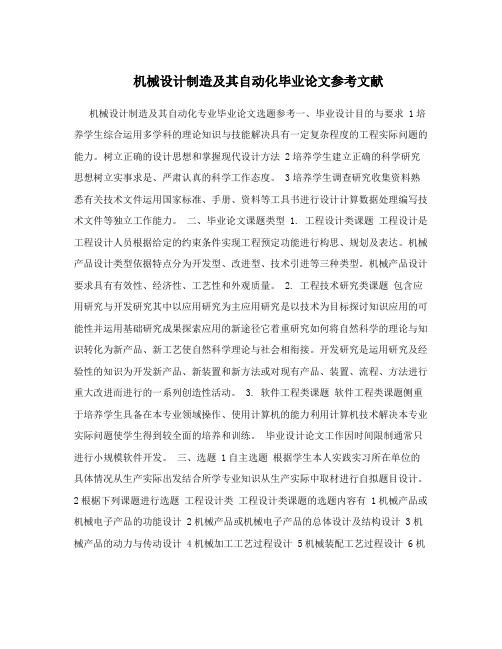
机械设计制造及其自动化毕业论文参考文献机械设计制造及其自动化专业毕业论文选题参考一、毕业设计目的与要求 1培养学生综合运用多学科的理论知识与技能解决具有一定复杂程度的工程实际问题的能力。
树立正确的设计思想和掌握现代设计方法 2培养学生建立正确的科学研究思想树立实事求是、严肃认真的科学工作态度。
3培养学生调查研究收集资料熟悉有关技术文件运用国家标准、手册、资料等工具书进行设计计算数据处理编写技术文件等独立工作能力。
二、毕业论文课题类型 1. 工程设计类课题工程设计是工程设计人员根据给定的约束条件实现工程预定功能进行构思、规划及表达。
机械产品设计类型依据特点分为开发型、改进型、技术引进等三种类型。
机械产品设计要求具有有效性、经济性、工艺性和外观质量。
2. 工程技术研究类课题包含应用研究与开发研究其中以应用研究为主应用研究是以技术为目标探讨知识应用的可能性并运用基础研究成果探索应用的新途径它着重研究如何将自然科学的理论与知识转化为新产品、新工艺使自然科学理论与社会相衔接。
开发研究是运用研究及经验性的知识为开发新产品、新装置和新方法或对现有产品、装置、流程、方法进行重大改进而进行的一系列创造性活动。
3. 软件工程类课题软件工程类课题侧重于培养学生具备在本专业领域操作、使用计算机的能力利用计算机技术解决本专业实际问题使学生得到较全面的培养和训练。
毕业设计论文工作因时间限制通常只进行小规模软件开发。
三、选题 1自主选题根据学生本人实践实习所在单位的具体情况从生产实际出发结合所学专业知识从生产实际中取材进行自拟题目设计。
2根椐下列课题进行选题工程设计类工程设计类课题的选题内容有 1机械产品或机械电子产品的功能设计 2机械产品或机械电子产品的总体设计及结构设计 3机械产品的动力与传动设计 4机械加工工艺过程设计 5机械装配工艺过程设计 6机械工艺装备设计包括刀具、夹具、量具、模具等 7专用机床和专业设备设计 8机械电子产品的数据采集系统、测试和监控1无轨运行运输小车的设计小车总体设计及行走机构、系统、控制系统的设计。
2024年外文参考文献格式要求

D.专著中析出的文献
〔序号〕 析出责任者.析出题名.见(英文用In):专著责任者.书名.出版地:出版者,出版年:起止页码.
〔12〕罗云.安全科学理论体系的`发展及趋势探讨.见:白春华,何学秋,吴宗之.21世纪安全科学与技术的发展趋势.北京:科学出版社,2000:1-5.
2024年外文参考文献格式要求
外文参考文献格式要求 篇1
单一作者著作的书籍:
姓,名字首字母.(年). 书名(斜体). 出版社所在城市:出版社.
Sheril, R. D. (1956). The terrifying future: Contemplating color television. San Diego: Halstead.
②磁带数据库[DB/MT]
③光盘图书[M/CD]
④磁盘软件[CP/DK]
⑤网上期刊[J/OL]
⑥网上电子公告[EB/OL]
期刊论文
[1]周庆荣,张泽廷,朱美文,等.固体溶质在含夹带剂超临界流体中的.溶解度[J].化工学报,1995,46(3):317 323
[2]Dobbs J M, Wong J M. Modification of supercritical fluid phasebehavior using polor coselvent[J]. Ind Eng Chem Res, 1987,26:56
B.专著
〔序号〕 主要责任者.文献题名〔M〕.出版地:出版者,出版年:页码.
〔3〕 刘国钧,郑如斯.中国书的故事〔M〕.北京:中国青年出版社,1979:115.
机械专业论文参考文献
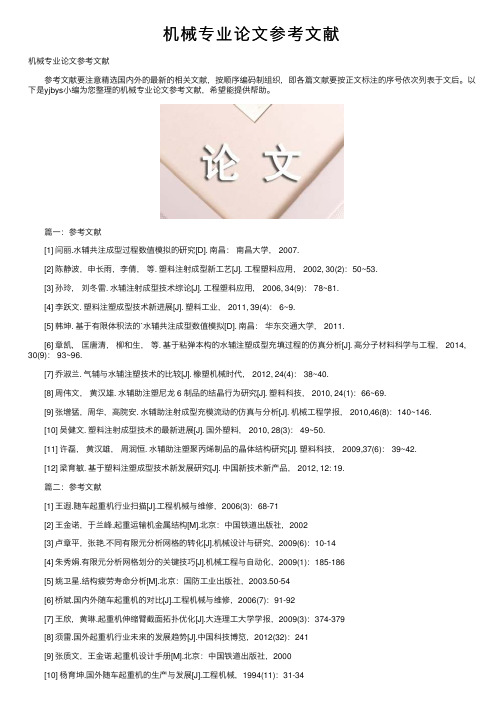
机械专业论⽂参考⽂献机械专业论⽂参考⽂献 参考⽂献要注意精选国内外的最新的相关⽂献,按顺序编码制组织,即各篇⽂献要按正⽂标注的序号依次列表于⽂后。
以下是yjbys⼩编为您整理的机械专业论⽂参考⽂献,希望能提供帮助。
篇⼀:参考⽂献 [1] 闫丽.⽔辅共注成型过程数值模拟的研究[D]. 南昌:南昌⼤学, 2007. [2] 陈静波,申长⾬,李倩,等. 塑料注射成型新⼯艺[J]. ⼯程塑料应⽤, 2002, 30(2):50~53. [3] 孙玲,刘冬雷. ⽔辅注射成型技术综论[J]. ⼯程塑料应⽤, 2006, 34(9): 78~81. [4] 李跃⽂. 塑料注塑成型技术新进展[J]. 塑料⼯业, 2011, 39(4): 6~9. [5] 韩坤. 基于有限体积法的`⽔辅共注成型数值模拟[D]. 南昌:华东交通⼤学, 2011. [6] 章凯,匡唐清,柳和⽣,等. 基于粘弹本构的⽔辅注塑成型充填过程的仿真分析[J]. ⾼分⼦材料科学与⼯程, 2014, 30(9): 93~96. [7] 乔淑兰. ⽓辅与⽔辅注塑技术的⽐较[J]. 橡塑机械时代, 2012, 24(4): 38~40. [8] 周伟⽂,黄汉雄. ⽔辅助注塑尼龙 6 制品的结晶⾏为研究[J]. 塑料科技, 2010, 24(1):66~69. [9] 张增猛,周华,⾼院安. ⽔辅助注射成型充模流动的仿真与分析[J]. 机械⼯程学报, 2010,46(8):140~146. [10] 吴健⽂. 塑料注射成型技术的最新进展[J]. 国外塑料, 2010, 28(3): 49~50. [11] 许磊,黄汉雄,周润恒. ⽔辅助注塑聚丙烯制品的晶体结构研究[J]. 塑料科技, 2009,37(6): 39~42. [12] 梁育敏. 基于塑料注塑成型技术新发展研究[J]. 中国新技术新产品, 2012, 12: 19. 篇⼆:参考⽂献 [1] 王遐.随车起重机⾏业扫描[J].⼯程机械与维修,2006(3):68-71 [2] 王⾦诺,于兰峰.起重运输机⾦属结构[M].北京:中国铁道出版社,2002 [3] 卢章平,张艳.不同有限元分析⽹格的转化[J].机械设计与研究,2009(6):10-14 [4] 朱秀娟.有限元分析⽹格划分的关键技巧[J].机械⼯程与⾃动化,2009(1):185-186 [5] 姚卫星.结构疲劳寿命分析[M].北京:国防⼯业出版社,2003.50-54 [6] 桥斌.国内外随车起重机的对⽐[J].⼯程机械与维修,2006(7):91-92 [7] 王欣,黄琳.起重机伸缩臂截⾯拓扑优化[J].⼤连理⼯⼤学学报,2009(3):374-379 [8] 须雷.国外起重机⾏业未来的发展趋势[J].中国科技博览,2012(32):241 [9] 张质⽂,王⾦诺.起重机设计⼿册[M].北京:中国铁道出版社,2000 [10] 杨育坤.国外随车起重机的⽣产与发展[J].⼯程机械,1994(11):31-34 [11] 刘宇,黄琳.起重机伸缩臂最优截⾯形式的研究[J].中国⼯程机械学报,2013(1):65-69 [12] 张青,张瑞军.⼯程起重机结构与设计[M].北京:化学⼯业出版社,2008 [13] 邓胜达,张建军.汽车起重机吊臂旁弯现象的分析[J].建筑机械化,2010(11):39-41 [14] 李志敏.伸缩吊臂滑块局部应⼒分析及变化规律研究[D].成都:西南交通⼤学.2009 [15] 蒋红旗.汽车起重机吊臂有限元优化设计[J].煤矿机械,2005(2):9-11 [16] 中国机械⼯业联合会.GB/T3811-2008 起重机设计规范[S].北京:中国标准出版社,2008 [17] 张宇,张仲鹏.类椭圆截⾯吊臂的约束扭转特性研究[J].机械设计与制造,2012(3):237-239 [18] 江兆⽂,成凯.基于 ANSYS 的全地⾯起重机吊臂有限元参数化建模与分析[J].建筑机械,2012(7):89-92 篇三:参考⽂献 [1] 邹银辉.煤岩体声发射传播机理研究[D].⼭东:⼭东科技⼤学硕⼠论⽂,2007 [2] 贾宝新,李国臻.矿⼭地震监测台站的空间分布研究与应⽤[J].煤炭学报,2010,35(12):2045-2048 [3] 柳云龙,⽥有,冯晅,等.微震技术与应⽤研究综述[J].地球物理学进展,2013,28(4):1801-1808 [4] 徐剑平,陈清礼,刘波,等.微震监测技术在油⽥中的应⽤[J].新疆⽯油天然⽓,2011,7(1):89-82 [5] 汪向阳,陈世利.基于地震波的油⽓管道安全监测[J].电⼦测量技术, 2008, 31(7): 121-123 [6] 何平.地铁运营对环境的振动影响研究[D].北京:北京交通⼤学,2012 [7] 陆基孟.地震勘探原理[M].⼭东:中国⽯油⼤学出版社,1990 [8] 崔⾃治.⼟⼒学[M].北京:中国电⼒出版社,2010 [9] 许红杰,夏永学,蓝航 ,等.微震活动规律及其煤矿开采中的应⽤ [J]. 煤矿开采,2012,17(2):93-95、16 [10] 李铁,张建伟,吕毓国,等.采掘活动与矿震关系[J].煤炭学报,2011,36(12):2127-2132 [11] 陈颙.岩⽯物理学[M].北京:北京⼤学出版社,2001 [12] 秦树⼈,季忠,尹爱军.⼯程信号处理[M].北京:⾼等教育出版社,2008 [13] 董越. SF6 ⾼压断路器在线监测及振动信号的分析[D].上海:上海交通⼤学,2008 [14] 张谦.基于地脉动观测的城市地区⼯程场地动参数及反演地下结构的研究[D].北京:北京交通⼤学,2012 [15] 刘振武,撒利明,巫芙蓉,等.中国⽯油集团⾮常规油⽓微地震监测技术现状及发展⽅向[J].⽯油地球物理勘探,2013,48(5):843-853 [16] 聂伟荣.多传感器探测与控制⽹络技术-地⾯运动⽬标震动信号探测与识别[D].南京:南京理⼯⼤学,2001(6). [17] T. Damarla and D. Ufford,Personnel detection using ground sensors[J].Proc. of SPIE, Orlando,FL, 2007, vol. 656205, 1-10. 机械制造专业论⽂参考⽂献范例 【1】 Bruno Agard,Bernard Penz. A simulated annealing method based on a clustering approach to determine bills of materials for a large product family. Int. J. Production Economics 117 (2009) 389–401. 【2】 Soon Chong Johnson Lim,Ying Liu,Wing Bun Lee.A methodology for building a semantically annotated multi-faceted ontology for product family modelling. Advanced Engineering Informatics 25 (2011) 147–161. 【3】 R.Galan,J.Racero,I.Eguia,J.M.Garcia. A systematic approach for product families formation in Recongurable Manufacturing Systems.Robotics and Computer-Integrated Manufacturing 23 (2007) 489–502. 【4】 Jacques Lamothe,Khaled Hadj-Hamou,Michel Aldanondo. An optimization model for selecting a product family and designing its supply chain. European Journal of Operational Research 169 (2006) 1030–1047. 【5】 Daniel Collado-Ruiz,Hesamedin Ostad-Ahmad-Ghorabi. Comparing LCA results out of competing products:developing reference ranges from a product family approach. Journal of Cleaner Production 18 (2010) 355–364. 【6】 L.Schulze,L.Li. Cooperative Coevolutionary Optimization Method for Product Family Design. 【7】 Heng Liu,Ozalp Ozer. Managing a product family under stochastic technological changes. Int. J. Production Economics 122 (2009) 567–580. 【8】 Soon Chong Johnson Lim,Ying Liu,Wing Bun Lee. Multi-facet product information search and retrieval using semantically annotated product family ontology. Information Processing and Management 46 (2010) 479–493. 【9】 Petri Helo,Qianli Xu,Kristianto,Roger Jianxin Jiao. Product Family Design And Logistics Decision Support System. 【10】 Taioun Kim,Hae Kyung Lee,Eun Mi Youn. Product Family Design based on Analytic Network Process. 【11】 Soon Chong Johnson Lim,Ying Liu,Wing Bun Lee. Using Semantic Annotation for Ontology Based Decision Support in Product Family Design【机械专业论⽂参考⽂献】相关⽂章:02-2211-1310-1402-0908-1209-1408-0709-0108-06。
自动生成论文参考文献范例
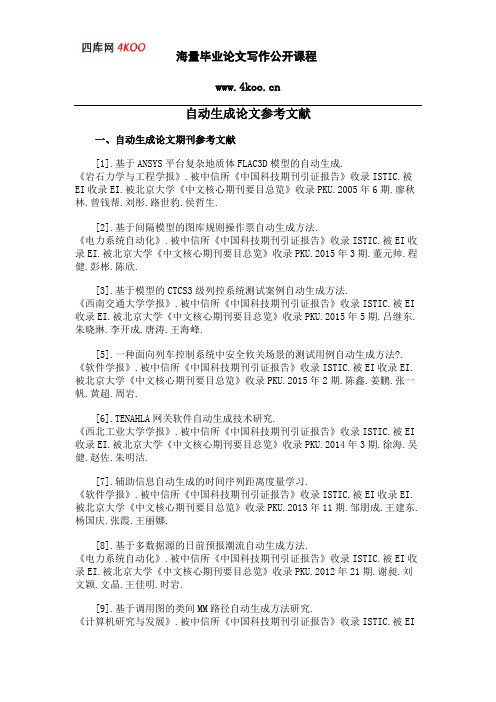
自动生成论文参考文献一、自动生成论文期刊参考文献[1].基于ANSYS平台复杂地质体FLAC3D模型的自动生成.《岩石力学与工程学报》.被中信所《中国科技期刊引证报告》收录ISTIC.被EI收录EI.被北京大学《中文核心期刊要目总览》收录PKU.2005年6期.廖秋林.曾钱帮.刘彤.路世豹.侯哲生.[2].基于间隔模型的图库规则操作票自动生成方法.《电力系统自动化》.被中信所《中国科技期刊引证报告》收录ISTIC.被EI收录EI.被北京大学《中文核心期刊要目总览》收录PKU.2015年3期.董元帅.程健.彭彬.陈欣.[3].基于模型的CTCS3级列控系统测试案例自动生成方法.《西南交通大学学报》.被中信所《中国科技期刊引证报告》收录ISTIC.被EI 收录EI.被北京大学《中文核心期刊要目总览》收录PKU.2015年5期.吕继东.朱晓琳.李开成.唐涛.王海峰.[5].一种面向列车控制系统中安全攸关场景的测试用例自动生成方法?. 《软件学报》.被中信所《中国科技期刊引证报告》收录ISTIC.被EI收录EI.被北京大学《中文核心期刊要目总览》收录PKU.2015年2期.陈鑫.姜鹏.张一帆.黄超.周岩.[6].TENAHLA网关软件自动生成技术研究.《西北工业大学学报》.被中信所《中国科技期刊引证报告》收录ISTIC.被EI 收录EI.被北京大学《中文核心期刊要目总览》收录PKU.2014年3期.徐海.吴健.赵佐.朱明洁.[7].辅助信息自动生成的时间序列距离度量学习.《软件学报》.被中信所《中国科技期刊引证报告》收录ISTIC.被EI收录EI.被北京大学《中文核心期刊要目总览》收录PKU.2013年11期.邹朋成.王建东.杨国庆.张霞.王丽娜.[8].基于多数据源的日前预报潮流自动生成方法.《电力系统自动化》.被中信所《中国科技期刊引证报告》收录ISTIC.被EI收录EI.被北京大学《中文核心期刊要目总览》收录PKU.2012年21期.谢昶.刘文颖.文晶.王佳明.时岩.[9].基于调用图的类间MM路径自动生成方法研究.《计算机研究与发展》.被中信所《中国科技期刊引证报告》收录ISTIC.被EI收录EI.被北京大学《中文核心期刊要目总览》收录PKU.2013年2期.何伟.赵瑞莲.朱群雄.二、自动生成论文参考文献学位论文类[1].项目自动生成的小学儿童数学问题解决认知诊断CAT编制.被引次数:19作者:涂冬波.基础心理学江西师范大学2009(学位年度)[2].软件测试用例自动生成技术研究.被引次数:17作者:李军义.计算机应用技术湖南大学2007(学位年度)[3].信息家电控制界面自动生成技术的研究.被引次数:1作者:张先部.信号与信息处理中国海洋大学2013(学位年度)[4].基于BIM的工程项目进度计划自动生成模型研究.被引次数:8作者:任桂娜.管理科学与工程哈尔滨工业大学2013(学位年度)[5].层次化建模中代码自动生成技术的研究及实现.被引次数:7作者:许琳.计算机软件与理论西安电子科技大学2011(学位年度)[6].基于场景的列控车载设备测试用例自动生成方法研究.被引次数:1 作者:赵伟慧.交通信息工程及控制北京交通大学2014(学位年度)[7].基于MDA的代码自动生成技术的研究与实现.被引次数:13作者:凌华德.软件工程华东师范大学2006(学位年度)[8].三维装配尺寸链自动生成的研究.作者:王光磊.机械设计及理论杭州电子科技大学2013(学位年度)[9].自动化软件测试技术研究.被引次数:33作者:金虎.计算机应用技术四川大学2006(学位年度)[10].基于MDL的可视化代码自动生成框架的研究与应用.作者:楚龙辉.计算机技术电子科技大学2015(学位年度)三、相关自动生成论文外文参考文献[1]OptimalAutomaticGenerationControlofInterconnectedPowerSystemCo nsideringNewStructuresofMatrixQ. NAIMULHASANIBRAHEEMPRABHATKUMAR《ElectricPowerComponentsandSystems》,被EI收录EI.被SCI收录SCI.20131/4[2]SuboptimalAutomaticGenerationControlofInterconnectedPowerSyste mUsingOutputVectorFeedbackControlStrategy. IBRAHEEMPRABHATKUMARNAIMULHASANNIZAMUDDIN 《ElectricPowerComponentsandSystems》,被EI收录EI.被SCI收录SCI.20129/12[3]Amodeloftheeffectsofautomaticgenerationcontrolsignalcharacteri sticsonenergystoragesystemreliability.T.CampbellT.H.Bradley《JournalofPowerSources》,被EI收录EI.被SCI收录SCI.2014Feb.1[4]DistributedAutomaticGenerationControlUsingFlatnessBasedApproac hforHighPenetrationofWindGeneration.VarianiM.H.TomsovicK.《IEEETransactionsonPowerSystems:APublicationofthePowerEngineeringSoc iety》,被EI收录EI.被SCI收录SCI.20133[5]Towardsautomatictweetgeneration:Acomparativestudyfromthetextsu mmarizationperspectiveinthejournalismgenre. ElenaLloretManuelPalomar《ExpertSystemswithApplication》,被EI收录EI.被SCI收录SCI.201316[6]Automaticgenerationcontrolusingtwodegreeoffreedomfractionalord erPIDcontroller.SanjoyDebbarmaLalitChandraSaikiaNidulSinha 《Internationaljournalofelectricalpowerandenergysystems》,被EI收录EI.被SCI收录SCI.2014Jun.[7]Solutiontoautomaticgenerationcontrolproblemusingfireflyalgorit hmoptimizedI~λD~μcontroller. SanjoyDebbarmaLalitChandraSaikiaNidulSinha《ISATransactions》,被EI收录EI.被SCI收录SCI.20142[8]AGCSignalModelingforEnergyStorageOperations.Donadee,J.Wang,J.《IEEETransactionsonPowerSystems:APublicationofthePowerEngineeringSoc iety》,被EI收录EI.被SCI收录SCI.20145[9]Automaticmultipartitegraphgenerationfromarbitrarydata.SandraálvarezGarcíaRicardoBaezaYatesNievesRBrisaboaJosepLluisLarribaP eyOscarPedreira《TheJournalofSystemsandSoftware》,被EI收录EI.被SCI 收录SCI.2014[10]Optimalmanagementoftheautomaticgenerationcontrolserviceinsmar tusergridsincludingelectricvehiclesanddistributedresources.C.BattistelliA.J.Conejo《ElectricPowerSystemsResearch》,被EI收录EI.被SCI收录SCI.2014Jun.四、自动生成论文专著参考文献[1]古代小说版本校记的计算机自动生成.周文业,2011第十届中国古代小说、戏曲文献与数字化研讨会[2]基于BIM技术的进度计划自动生成模型.任桂娜.孙成双,20122012中国工程管理论坛[3]一种Android发行版应用的自动生成系统.郑文平.曹三省,20122012国际传输与覆盖研讨会[4]基于改进菌群算法测试用例自动生成方法的研究.黄今慧.张欣欣,20122012(第五届)全国网络与信息安全学术会议[5]西门子PLC源程序自动生成的设计与实现研究.徐志洋.程运安.程磊,2012第七届仪表、自动化与先进集成技术大会暨第六届测控技术与仪器仪表学术大会[6]基于GIS数据自动生成城市三维模型的技术探讨.曹峰,2012第九届长三角科技论坛——测绘分论坛[7]邮政便民服务站WEB接入系统前台业务代码自动生成技术研究.王静妮,2011陕西省通信学会2011年学术年会[8]短路电流值图表自动生成的实现.何宗明,20112011’(第二届)全国煤矿机械与救援装备高层论坛暨新产品技术交流会[9]家庭网络控制界面自动生成技术及仿真.韩颖铮.陆以勤,2010中国教育和科研计算机网CERNET第十七届学术年会[10]一种基于扩展WSDL的Web服务测试数据自动生成方法.蒋乃乾.李心科,20112011年振动与噪声测试峰会。
机械英文参考文献及翻译
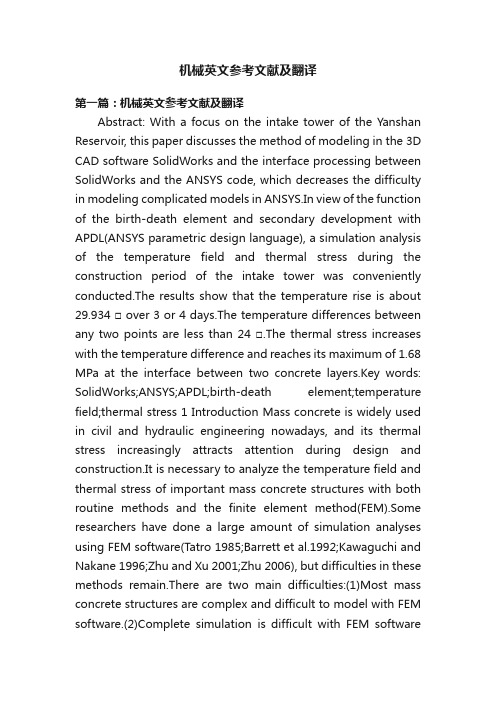
机械英文参考文献及翻译第一篇:机械英文参考文献及翻译Abstract: With a focus on the intake tower of the Yanshan Reservoir, this paper discusses the method of modeling in the 3D CAD software SolidWorks and the interface processing between SolidWorks and the ANSYS code, which decreases the difficulty in modeling complicated models in ANSYS.In view of the function of the birth-death element and secondary development with APDL(ANSYS parametric design language), a simulation analysis of the temperature field and thermal stress during the construction period of the intake tower was conveniently conducted.The results show that the temperature rise is about29.934 □ over 3 or 4 days.The temperature differences betweena ny two points are less than 24 □.The thermal stress increases with the temperature difference and reaches its maximum of 1.68 MPa at the interface between two concrete layers.Key words: SolidWorks;ANSYS;APDL;birth-death element;temperature field;thermal stress 1 Introduction Mass concrete is widely used in civil and hydraulic engineering nowadays, and its thermal stress increasingly attracts attention during design and construction.It is necessary to analyze the temperature field and thermal stress of important mass concrete structures with both routine methods and the finite element method(FEM).Some researchers have done a large amount of simulation analyses using FEM software(Tatro 1985;Barrett et al.1992;Kawaguchi and Nakane 1996;Zhu and Xu 2001;Zhu 2006), but difficulties in these methods remain.There are two main difficulties:(1)Most mass concrete structures are complex and difficult to model with FEM software.(2)Complete simulation is difficult with FEM softwarebecause of the complex construction processes and boundary conditions of concrete.The structure of the intake tower of the Yanshan Reservoir is complex.It is 34.5 m high and there is a square pressure tunnel at the bottom, the side length of which is 6 m.The intake tower was modeled in the 3D CAD software SolidWorks and imported into ANSYS with an interface tool.Then, using the APDL program, analysis of the temperature field and thermal stress during construction was conducted.2 Modeling in SolidWorks and interface processing between SolidWorks and ANSYS 2.1 Modeling in SolidWorks SolidWorks is a CAD/CAE/CAM/PDM desktop system, and the first 3D mechanical CAD software in Windows developed by the SolidWorks company.It provides product-level automated design tools(Liu and Ren 2005).The outside structure of the intake tower is simple but the internal structure is relatively complex.Therefore, the process of modeling is undertaken from the inside to the outside.The integrated and internal models of the intake tower are shown in Fig.1 and Fig.2.图片Fig.1 Integrated model Fig.2 Cross section 2.2 Interface processing between SolidWorks and ANSYS ANSYS is a type of large universal finite element software that has a powerful ability to calculate and analyze aspects of structure, thermal properties, fluid, electromagnetics, acoustics and so on.In addition, the interface of ANSYS can be used to import the CAD model conveniently(Zhang 2005), which greatly reduces the difficulties of dealing with complex models.The interface tools are given in Table 1.Table 1 CAD software packages and preferred interface tools 图表1After modeling in SolidWorks, it is necessary to save the model as a type of Parasolid(*.x_t)so as to import it into ANSYS correctly.Then, in ANSYS, the importing of the model iscompleted with the command “PARAIN, Name, Extension, Path, Entity, FMT, Scale” or the choice of “FileDImportDPARA...” in the GUI interface.There are two means of importing: selecting or not selecting “Allow Defeaturing”,the differences of which are shown in Fig.3 and Fig.4.图片Fig.3 Importing with defeaturing Fig.4 Importing without defeaturing 3 Analysis of temperature field of intake tower The temperature analysis of the intake tower during the construction period involves aspects of the temperature field and thermal stress.The calculation must deal with the problems of simulation of layered construction, dynamic boundary conditions, hydration heat, dynamic elasticity modulus, autogenous volume deformation of concrete and thermal creep stress, which are difficult to simulate directly in ANSYS.APDL is a scripting language based on the style of parametric variables.It is used to reduce a large amount of repetitive work in analysis(Gong and Xie 2004).This study carried out a simulation analysis of the temperature field considering nearly all conditions of construction, using the birth-death element and programming with APDL.3.1 Solving temperature field principle 3.1.1 Unsteady temperature field analysis The temperature of concrete changes during the construction period due to the effect of hydration heat of cement.This problem can be expressed as a heat conduction problem with internal heat sources in the area.The unsteady temperature field T(x, y, z,D)is written as(Zhu 1999): 公式1where □ is the thermal conductivity of concrete, c is the specific heat of concrete, □ is the density of concrete, □ is the adiabatic temperature rise of concrete, and □ is the age of concrete.In the 3D unsteady temperature field analysis, the functional form I e(T)is 公式2 where □R is a subfield of unit e;□0is the area on surface D , which is only in boundary units;c □ □ □□;□ is the exothermic coefficient;the thermal diffusivity c □ □ □ □;and isthe air temperature.a T3.1.2 Initial conditions and boundary conditions of concrete The initial conditions are the distribution laws of the initial transient temperature of internal concrete.The calculated initial temperature of concrete is 10 □.The index formula of hydration heat of cement is 公式 3 where t is the pouring time.The conversion between Q and □ is 公式4 The boundary conditions involve the laws of interaction between concrete and the surrounding medium.When concrete is exposed to the air, the boundary condition is 公式5 where n is the normal direction.Both and a T □ are constants or variables(Ashida and Tauchert 1998;Lin and Cheng 1997).During the maintenance period, the insulation materials of concrete are steel formworks and straws, and the exothermic coefficient of the outer surface is reduced as equivalent processing.The exothermic coefficients of the steel formwork and the straw are 45 kJ/(m2h+0)and 10 kJ/(m2h+0),respectively.Based on the local temperature during construction, the following formula can be fitted according to the temperature variation curve: 公式63.2 Analysis of temperature field in ANSYS The simulation scheme of layered construction, which is based on the real construction scheme, is shown in T able 2.The pouring days in Table 2 are all the total days of construction for each layer.A layer is not poured until the former layer is poured.图表2The feature points are selected in every layer above the base plate.The maximum temperatures and the temperature curvesare given in Table 3 and Fig.5, respectively.Table 3 Coordinates and maximum temperature of feature points 图表3 图片5 Fig.5 Maximum temperature curves Fig.5 shows that the maximum temperature of each layer occurs on the 3rd or 4th day after pouring, and then the temperature decreases with time, which is consistent with related literature(Lin and Cheng 1997;Luna and Wu 2000;Wu and Luna 2001).In Fig.5, the numbers of feature points from 2 to 8 are corresponding to their maximum temperature curves from Nodetemp 2 to Nodetemp 8, and the curve of Nodetemp 9 is the air temperature curve.Feature point 8, the maximum temperature of which is 29.934 □ , occurrin g on the 206th day of the total construction period, shows the maximum temperature rise during the construction period.Feature point 4, the coordinates of which are(16.4, 16.0, 5.0), shows the maximum temperature difference of 23.5340.4 Analysis of thermal stress of intake tower Expansion or contraction of the structure occurs during heating and cooling.If the expansion or contraction of different parts is inconsistent, then thermal stress occurs.The indirect method was adopted in this study: the temperature of nodes was first obtained in analysis of the temperature field, and then applied to the structure as a body load.4.1 Selection of calculating parameters The parameters of concrete are given in Table 4.The elasticity modulus is 公式7 T able 4 Parameters of concrete 图表4 The creep effect must be considered in analysis of temperature stress.The creep degree of concrete is influenced by the cement type, water-cement ratio and admixture.The formula of the creep degree is 公式8 Considering the creep degree, the formula of the elasticity modulus is adjusted to be 公式94.2 Analysis of thermal stress in ANSYS As in analysis of thetemperature field, feature points were selected in each layer above the base plate, and their coordinates were the same as those in the temperature field analysis.The maximum thermal stress of each point is shown in Table 5.Feature point 9, the coordinates of which are(17.4, 10.8, 8.0), is the point with the maximum thermal stress.Table 5 Maximum thermal stress of feature points 图表5The thermal stress curves of feature points are shown in Fig.6.图片6Fig.6 Maximum stress curves In Fig.6, the numbers of feature points from 2 to 9 are corresponding to their maximum stress curves from S1_2 to S1_9, and the S1_10 curve is the ultimate tensile stress o f concrete.The formula of concrete’s ultimate tensile stress is 公式10 The figures and table show that the maximum thermal stress of the intake tower is 1.68 MPa, occurring on the 90th day of the construction period, which is the end of the third layer maintenance period and the beginning of the pouring of the fourth layer.It is known that the thermal stress increases with the temperature difference.Feature point 9 is located at the interface between the third layer and the fourth layer.Thus, it is postulated that the maximum thermal stress is caused by the instantaneous temperature difference between two layers in the pouring period.In Fig.6, the S1_10 curve shows the ultimate tensile stress curve of concrete.It is known that the maximum thermal stress of each point in the intake tower during the construction period is less than the ultimate tensile stress of concrete.5 Conclusions ⑴ The problem of the interface between SolidWorks and ANSYS is resolved in this study, realizing an effective combination of the advantages of both SolidWorks and ANSYS and providing a basis for analysis in ANSYS.(2)Using abirth-death element and considering layered construction, dynamic boundary conditions, hydration heat, the dynamic elasticity modulus, autogenous volume deformation and creep of concrete, the temperature field and thermal stress during the construction period are conveniently obtained due to the virtues of secondary development with APDL.(3)The analysis of temperature shows that the temperature of concrete rises rapidly in the early stage of construction, reaches a maximum value of 29.934 □ on the 3rd or 4th day after pouring, drops thereafter, and is consistent with air temperature after about 30 days.The thermal stress increases with the temperature difference, and the occurrence time of the maximum thermal stress is consistent with that of the maximum temperature difference.The maximum thermal stress occurs at the interface of new and old layers and is caused by the instantaneous temperature difference, the value of which is 1.68 MPa.(4)The maximum thermal stress is less than the ultimate tensile stress of concrete, which illustrates that the curing measures in construction are effective.Meanwhile, in view of the fact that the maximum thermal stress occurs at the interface of new and old layers, more attention should be paid to it, especially when there is a long interval of time between the pouring of different layers.References Ashida, F., and Tauchert, T.R.1998.An inverse problem for determination of transient surface temperature from piezoelectric sensor measurement.Journal of Applied Mechanics, 65(2), 367-373.[doi:10.1115/1.2789064] Barrett, P.R., Foadian, H., James, R.J., and Rashid, Y.R.1992.Thermal-structural analysis methods for RCC dams.Proceedings of the Conference of Roller Concrete III, 407-422.San Diego: ASCE.Gong, S.G., and Xie, mands and Parametric Programming inANSYS.Beijing: China Machine Press.(in Chinese)Kawaguchi, T., and Nakane, S.1996.Investigations on determining thermal stress in massive concrete structures.ACI Materials Journal, 93(1), 96-101.Lin, J.Y., and Cheng, T.F.1997.Numerical estimation of thermal conductivity from boundary temperature measurements.Numerical Heat Transfer, 32(2), 187-203.[doi:10.1080/***87] Liu, L.J., and Ren, J.P.2005.Application of the secondary development in SolidWorks.Mechanical Management and Development,(1), 74-75.(in Chinese)Luna, R., and Wu, Y.2000.Simulation of temperature and stress fields during RCC dam construction.Journal of Construction Engineering and Management, ASCE, 126(5), 381-388.[doi: 10.1061/(ASCE)0733-9364(2000)126:5(381)] Tatro, S.B.and Schrader, E.K.1985.Thermal consideration for roller compacted concrete.ACI Structural Journal, 82(2), 119-128.Wu, Y., and Luna, R.2001.Numerical implementation of temperature and creep in mass concrete.Finite Elements in Analysis and Design, 37(2), 97-106.[doi:10.1016/S0168-874X(00)00022-6] Zhang, J.2005.Interface design between AutoCAD and ANSYS.Chinese Quarterly of Mechanics, 26(2), 257-262.(in Chinese)Zhu, B.F.1999.Thermal Stresses and Temperature Control of Mass Concrete.Beijing: China Electric Power Press.(in Chinese)Zhu, B.F., and Xu, P.2001.Methods for stress analysis simulating the construction process of high concrete dams.Dam Engineering, 6(4), 243-260.Zhu, B.F.2006.Current situation and prospect of temperature control and cracking prevention technology for concrete dam.Journal of Hydraulic Engineering, 37(12), 1424-1432.(in Chinese)第二篇:英文文献翻译(模版)在回顾D和H的文章时,我愿意第一个去单独地讨论每一篇,然后发表一些总体的观点。
外文参考文献的格式
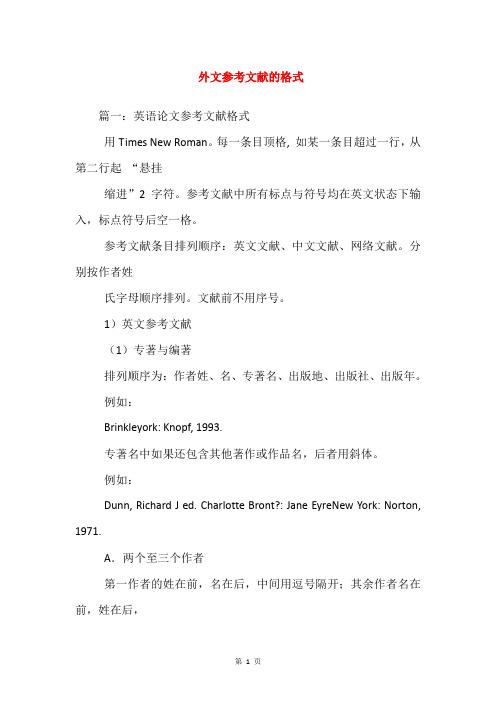
外文参考文献的格式篇一:英语论文参考文献格式用Times New Roman。
每一条目顶格, 如某一条目超过一行,从第二行起“悬挂缩进”2字符。
参考文献中所有标点与符号均在英文状态下输入,标点符号后空一格。
参考文献条目排列顺序:英文文献、中文文献、网络文献。
分别按作者姓氏字母顺序排列。
文献前不用序号。
1)英文参考文献(1)专著与编著排列顺序为:作者姓、名、专著名、出版地、出版社、出版年。
例如:Brinkleyork: Knopf, 1993.专著名中如果还包含其他著作或作品名,后者用斜体。
例如:Dunn, Richard J ed. Charlotte Bront?: Jane EyreNew York: Norton, 1971.A.两个至三个作者第一作者的姓在前,名在后,中间用逗号隔开;其余作者名在前,姓在后,中间无逗号;每个作者之间用逗号隔开,最后一个作者的姓名前用“and”,后用句号。
例如:B. 三个以上作者第一作者姓名(姓在前,名在后,中间加逗号)后接“et al.”,其他作者姓名省略。
例如:University of Hawaii Press, 1997.C. 同一作者同一年出版的不同文献,参照下例:Widdowson, Hey G1998a.Widdowson, Hey G. Cambridge:Cambridge University Press, 1998b.(2)论文集参照下例:Thompson, Pett. “Modal Verbs in Academic Writing”. In Ben Kettlemann & York: Rodopi, 2019: 305-323.(3)百科全书等参考文献参照下例:Fagan, Jeffrey. “Gangs and Drugs”. ork: Macmillan, 2019.(4)学术期刊论文参照下例:Murphy, Karen. “Meaningful Connections: Using Technology in PrimaryClassrooms”.(5)网络文献参照下例:----“Everything You Ever Wanted to Know About URL”..2)中文参考文献(1)专著参照下例:皮亚杰.结构主义[M] .北京:商务印书馆,1984.(2)期刊文章参照下例:杨忠,张韶杰.认知语音学中的类典型论[J] .外语教学与研究,1999,(2):1-3.(3)学位论文参照下例:梁佳.大学英语四、六级测试试题现状的理论分析与问题研究[D] .湖南大学,2019.(4)论文集参照下例:许小纯.含义和话语结构[A].李红儒.外国语言与文学研究[C] .哈尔滨:黑龙江人民出版社,1999:5-7.(5)附录篇二:中英文参考文献格式中文参考文献格式参考文献(即引文出处)的类型以单字母方式标识:M——专著,C——论文集,N——报纸文章,J——期刊文章,D——学位论文,R——报告,S——标准,P——专利;对于不属于上述的文献类型,采用字母“Z”标识。
机械论文的外文参考文献1
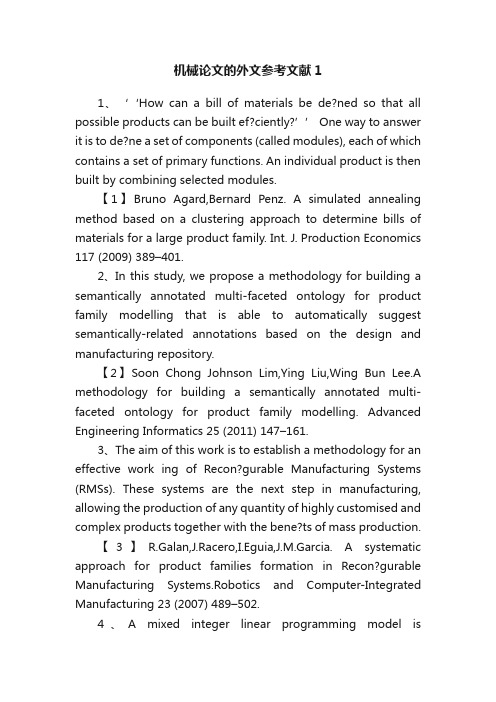
机械论文的外文参考文献11、‘‘How can a bill of materials be de?ned so that all possible products can be built ef?ciently?’’ One way to answer it is to de?ne a set of components (called modules), each of which contains a set of primary functions. An individual product is then built by combining selected modules.【1】Bruno Agard,Bernard Penz. A simulated annealing method based on a clustering approach to determine bills of materials for a large product family. Int. J. Production Economics 117 (2009) 389–401.2、In this study, we propose a methodology for building a semantically annotated multi-faceted ontology for product family modelling that is able to automatically suggest semantically-related annotations based on the design and manufacturing repository.【2】Soon Chong Johnson Lim,Ying Liu,Wing Bun Lee.A methodology for building a semantically annotated multi-faceted ontology for product family modelling. Advanced Engineering Informatics 25 (2011) 147–161.3、The aim of this work is to establish a methodology for an effective work ing of Recon?gurable Manufacturing Systems (RMSs). These systems are the next step in manufacturing, allowing the production of any quantity of highly customised and complex products together with the bene?ts of mass production.【3】R.Galan,J.Racero,I.Eguia,J.M.Garcia. A systematic approach for product families formation in Recon?gurable Manufacturing Systems.Robotics and Computer-Integrated Manufacturing 23 (2007) 489–502.4、A mixed integer linear programming model isinvestigated that optimizes the operating cost of the resulting supply chain while choosing the product variants and can de?ne the product family and its supply chain simultaneously.【4】Jacques Lamothe,Khaled Hadj-Hamou,Michel Aldanondo. An optimization model for selecting a product family and designing its supply chain. European Journal of Operational Research 169 (2006) 1030–1047.5、This paper presents LCP-families, a concept to develop reference ranges for environmental impact of a new product. A new product can be catalogued as environmentally better or worse than a percentage of its competitors, depending on what position it occupies in its LCP-family.【5】Daniel Collado-Ruiz,Hesamedin Ostad-Ahmad-Ghorabi. Comparing LCA results out of competing products: developing reference ranges from a product family approach. Journal of Cleaner Production 18 (2010) 355–364.6、This paper has proposed a cooperative coevolutionary optimization method for optimal design of product family with multi–level commonality .【6】L.Schulze,L.Li. Cooperative Coevolutionary Optimization Method for Product Family Design.7、This paper characterizes a decision framework by whicha ?rm can manage generational product replacements under stochastic technological changes.【7】Heng Liu,Ozalp Ozer. Managing a product family under stochastic technological changes. Int. J. Production Economics 122 (2009) 567–580.8、This paper proposes an information search and retrieval framework based on the semantically annotated multi-facet product family ontology to save time for the ontologydevelopment in design engineering.【8】Soon Chong Johnson Lim,Ying Liu,Wing Bun Lee. Multi-facet product information search and retrieval using semantically annotated product family ontology. Information Processing and Management 46 (2010) 479–493.9、The purpose of the paper is to present Product V ariety Analysis (PVA) approach to coordinated and synchronized fows of information about products and production processes among various supply chain members.【9】Petri Helo,Qianli Xu,Kristianto,Roger Jianxin Jiao. Product Family Design And Logistics Decision Support System.10、The purpose of this paper is to propose a product family design architecture that satisfies customer requirements with minimal efforts.【10】Taioun Kim,Hae Kyung Lee,Eun Mi Y oun. Product Family Design based on Analytic Network Process.11、This paper presents a conceptual framework of using semantic annotation for ontology based decision support in product family design.【11】Soon Chong Johnson Lim,Ying Liu,Wing Bun Lee. Using Semantic Annotation for Ontology Based Decision Support in Product Family Design。
机电论文参考文献
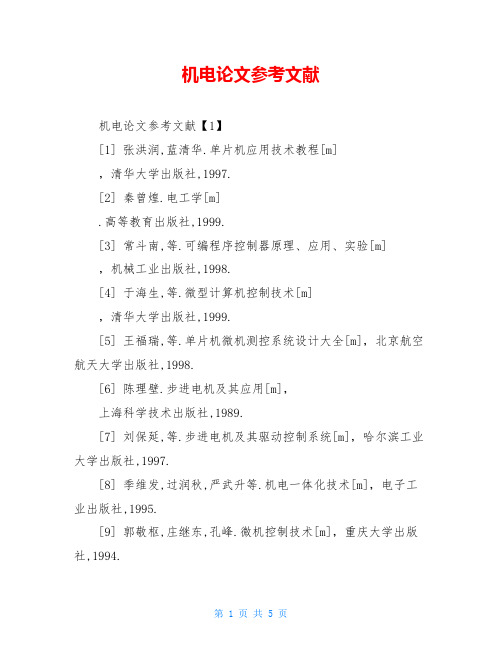
机电论文参考文献机电论文参考文献【1】[1] 张洪润,蓝清华.单片机应用技术教程[m],清华大学出版社,1997.[2] 秦曾煌.电工学[m].高等教育出版社,1999.[3] 常斗南,等.可编程序控制器原理、应用、实验[m],机械工业出版社,1998.[4] 于海生,等.微型计算机控制技术[m],清华大学出版社,1999.[5] 王福瑞,等.单片机微机测控系统设计大全[m],北京航空航天大学出版社,1998.[6] 陈理壁.步进电机及其应用[m],上海科学技术出版社,1989.[7] 刘保延,等.步进电机及其驱动控制系统[m],哈尔滨工业大学出版社,1997.[8] 季维发,过润秋,严武升等.机电一体化技术[m],电子工业出版社,1995.[9] 郭敬枢,庄继东,孔峰.微机控制技术[m],重庆大学出版社,1994.[10] 刘国荣.单片微型计算机技术[m],机械工业出版社,1996.[11] 王福瑞.单片微机测控系统设计大全[m],北京航空航天大学出版社,1998.[12] 何立民.单片机应用技术选编[m],北京航空航天大学出版社,1993.机电论文参考文献【2】[1] 巩云鹏、田万禄等主编.机械设计课程设计.沈阳:东北大学出版社2000[2] 孙志礼,冷兴聚,魏严刚等主编.机械设计.沈阳:东北大学出版社2000[3] 刘鸿文主编.材料力学.北京:高等教育出版社1991[4] 哈尔滨工业大学理论力学教研组编.理论力学.北京:高等教育出版社1997[5] 大连理工大学工程画教研室编.机械制图.北京:高等教育出版社1993[6] 孙桓,陈作模主编.机械原理.北京:高等教育出版社2000[7] 高泽远,王金主编.机械设计基础课程设计.沈阳:东北工学院出版社1987[8] 喻子建,张磊、邵伟平、喻子建主编.机械设计习题与解题分析.沈阳:东北大学出版社2000[9] 张玉,刘平主编.几何量公差与测量技术.沈阳:东北大学出版社1999[10] 成大先主编.机械设计手册(减(变)速器.电机与电器)化学工业出版社[11]《煤矿总工程师工作指南》编委会编著.《矿总工程师工作指南》(上).北京:煤炭工业出版社,1990.7[12] 严万生等编著.《矿山固定机械手册》..北京:煤炭工业出版社,1986.5,第1版[13]孙玉蓉等编著.《矿井提升设备》.北京:煤炭工业出版社,1995.1,第1版[14] 中国矿业学院主编.《矿井提升设备》.北京:煤炭工业出版社,1980.9,第1版[15] 煤炭工业部制定.《煤矿安全规程》.煤炭工业出版社,1986,第1版[16] 谢锡纯,李晓豁主编.《矿山机械与设备》.徐州:中国矿业大学出版社,2000[17] 能源部制定.《煤矿安全规程》.北京:煤炭工业出版社,1992[18] 王志勇等编.《煤矿专用设备设计计算》.北京:煤炭工业出版社,1984[19] 彭兆行编.《矿山提升机械设计》.北京:机械工业出版社,1989[20] 机械设计、机械设计基础课程设计,王昆等主编,北京:高等教育出版社,1996机电论文参考文献【3】[1] 阎石数字电子电路[z] 北京:中央广播电视大学出版社1992 [2] 实用电子电路手册[m] 北京:高等教育出版社1992 [3] 吴琼水,曾立波,雷俊锋.max7000s在步进电机微机控制系统中的应用[j].电子技术.no.12,2001.47-48[4] 高军礼, 卢卓权.步进电机一体化控制系统的设计[j].微计算机信息,20XX, 4-1: 69-70[5] 童诗白模拟电子技术基础[m]北京:高等教育出版社1982 [6] 李巡 mcs-51 系列微型计算机原理与应用[m]北京航空航天大学出版社2001,10-1 [7] 张毅钢 mcs-51 单片机应用设计[m] 哈尔滨工业大学出版社2021,4-1 [8] 周航慈单片机应用程序设计技术[m] 北京航空航天大学出版社2021,2-1 [9] 赵长德李华李东mcs-51/98 单片机原理与应用[m] 机械工业出版社1900,1-1 [10] 赵志英张友德单片微型机原理、应用与实验[m] 复旦大学出版社2021。
自动焊接机论文参考文献范例

自动焊接机论文参考文献一、自动焊接机论文期刊参考文献[1].S型触头银触点自动焊接机的设计.《焊接技术》.被中信所《中国科技期刊引证报告》收录ISTIC.被北京大学《中文核心期刊要目总览》收录PKU.2010年9期.陈鹏.白纯洁.王晓勇.马俊武.[2].带钢自动焊接机气动及液压系统的设计.《机械制造》.被中信所《中国科技期刊引证报告》收录ISTIC.2012年12期.周海燕.郭湘宇.[3].大直径筒体马鞍形曲线自动焊接机的研制.《焊接学报》.被中信所《中国科技期刊引证报告》收录ISTIC.被EI收录EI.被北京大学《中文核心期刊要目总览》收录PKU.2000年1期.张忠厚.[4].农机零件相贯线自动焊接机的设计.《农机化研究》.被北京大学《中文核心期刊要目总览》收录PKU.2010年7期.刘立涛.弋景刚.姜海勇.刘江涛.[5].双焊枪自动焊接机控制系统设计.《制造业自动化》.被中信所《中国科技期刊引证报告》收录ISTIC.被北京大学《中文核心期刊要目总览》收录PKU.2012年19期.刘江涛.弋景刚.[7].采煤机螺旋滚筒自动焊接系统设计.《机床与液压》.被中信所《中国科技期刊引证报告》收录ISTIC.被北京大学《中文核心期刊要目总览》收录PKU.2013年20期.齐帅.吕士峰.张燕.程岩.卓少凡.[8].浅谈自动焊接机在机械焊接中的应用.《黑龙江科技信息》.2014年33期.倪良琴.[9].传感器在双工位自动焊接机的应用.《电子世界》.2014年24期.谈琰.[10].数控环缝自动焊接机设计.《焊接技术》.被中信所《中国科技期刊引证报告》收录ISTIC.被北京大学《中文核心期刊要目总览》收录PKU.2013年3期.杨丽.黄燕梅.宋建武.二、自动焊接机论文参考文献学位论文类[1].新能源汽车供电系统自动焊接机机械系统研制.作者:李京.机械制造及其自动化长春理工大学2014(学位年度)[2].五自由度龙门自动焊接机的研究.被引次数:1作者:刘光利.机械制造及其自动化长春理工大学2013(学位年度)[3].管道全位置自动焊接机的研究.作者:曾昭奇.机械制造及其自动化哈尔滨工业大学2008(学位年度)[4].多功能自动焊接机的研制.作者:丁松森.电子与通信工程苏州大学2012(学位年度)[5].DOE在焊接插针设备优化中的运用研究.被引次数:1作者:刘志斌.工业工程上海交通大学2012(学位年度)[6].管道自动焊接机控制系统的研究.作者:郝永臣.机械工程哈尔滨理工大学2007(学位年度)[7].基于三坐标测量技术的智能焊接机设计.作者:程奉玉.机械设计及理论山东科技大学2014(学位年度)[8].MB600全自动金丝球焊接机的研制.作者:岳学明.机械工程哈尔滨工业大学2010(学位年度)[9].硬质合金路面铣刨刀的结构优化与焊接工艺研究.作者:涂建刚.机械工程华中科技大学2006(学位年度)[10].火车锻造钩尾框自动焊接机的设计开发.作者:朱斌.机械工程及其自动化南京理工大学2006(学位年度)三、相关自动焊接机论文外文参考文献[1]AMATHEMATICALMODELOFSHORTCIRCUITINGTRANSFERINTHEHIGHSPEEDOSCIL LATINGMAGPROCESSDEVELOPMENTOFAUTOMATICMAGWELDINGMACHINEWITHARCSENSORA NDITSAPPLICATIONTOFIELDWELDINGOFGASPIPELINES.S.KodamaY.IchiyamaY.IkunoN.Baba《WeldingintheWorld:JournaloftheInternationalInstituteofWelding:Journ aloftheInternationalInstituteofWelding》,被EI收录EI.被SCI收录SCI.200478[2]ComparisonoftheConstructedControlMethodsforaFrictionWeldingMac hine.R.BayindirH.Ates《MaterialsandManufacturingProcesses》,被EI收录EI.被SCI收录SCI.20052[3]Specializedequipmentforautomaticweldingofaircraftstructures. V.A.KhaustovV.M.ArbuzovO.V.Babichev《WeldingInternational》,被EI收录EI.20119[4]Studyonfullautomaticarcweldingmachineforsphericaltank. JiangLipeiZhangJiayingYuJianrong《Chinawelding》,被EI收录EI.20021[5]OptimizationofWeldingRoutebyAutomaticMachineUsingReinforcement LearningMethod.YasuhisaOkumoto《Journalofshipproduction》,被EI收录EI.20083[6]Developmentofautomobiledriveshaftautomaticweldingmachine. TieweiBu2013[7]Developmentofautomobiledriveshaftautomaticweldingmachine. TieweiBu2013[8]Thedevelopmentofautomaticgirthweldingmachinewithdualarmforauto mobileaxle.JinhuSong2013[9]Thedevelopmentofautomaticgirthweldingmachinewithdualarmforauto mobileaxle.JinhuSong2013[10]Spliceweldingwithanautomaticlaserweldingmachine. 《WireIndustry:WireIndustrywithWireIndustryYearbook》,被EI收录EI.2005851四、自动焊接机论文专著参考文献[1]Petri网在自动焊接机机械手程序设计中的应用.金沙,20122012年西南三省一市自动化与仪器仪表学术年会[6]全位置CO<,2>气体保护自动焊接机.王刚.赵成文,1997第八次全国焊接会议[7]温控器感温筒自动焊接机的可靠性设计.吴冉泉.张绍裘,1995海峡两岸机械产品可靠性设计研讨会[8]自动焊接机的选择与调试(软钎焊).朱伯瀛,1987中国电子学会生产技术学会1987年第三届学术年会[9]准东锅炉钢结构中部柱的制造加工.冯利平.李慧鹏.陈姣,2012中国钢结构协会锅炉钢结构分会第十三届年会[10]轨道车辆用铝合金厚板角接自动焊工艺.姚肖洁.侯振国.王陆钊.钮旭晶.田忠利,2013“迈向智慧焊接”国际论坛。
机械设计论文参考文献

本文为word格式,下载后可编辑修改,也可直接使用机械设计论文参考文献机械设计论文参考文献(一)[1] 王遐.随车起重机行业扫描[J].工程机械与维修,2006(3):68-71[2] 王金诺,于兰峰.起重运输机金属结构[M].北京:中国铁道出版社,2002[3] 卢章平,张艳.不同有限元分析网格的转化[J].机械设计与研究,2009(6):10-14[4] 朱秀娟.有限元分析网格划分的关键技巧[J].机械工程与自动化,2009(1):185-186[5] 姚卫星.结构疲劳寿命分析[M].北京:国防工业出版社,2003.50-54[6] 桥斌.国内外随车起重机的对比[J].工程机械与维修,2006(7):91-92[7] 王欣,黄琳.起重机伸缩臂截面拓扑优化[J].大连理工大学学报,2009(3):374-379[8] 须雷.国外起重机行业未来的发展趋势[J].中国科技博览,2012(32):241[9] 张质文,王金诺.起重机设计手册[M].北京:中国铁道出版社,2000[10] 杨育坤.国外随车起重机的生产与发展[J].工程机械,1994(11):31-34[11] 刘宇,黄琳.起重机伸缩臂最优截面形式的研究[J].中国工程机械学报,2013(1):65-69[12] 张青,张瑞军.工程起重机结构与设计[M].北京:化学工业出版社,2008[13] 邓胜达,张建军.汽车起重机吊臂旁弯现象的分析[J].建筑机械化,2010(11):39-41[14] 李志敏.伸缩吊臂滑块局部应力分析及变化规律研究[D].成都:西南交通大学.2009[15] 蒋红旗.汽车起重机吊臂有限元优化设计[J].煤矿机械,2005(2):9-11[16] 中国机械工业联合会.GB/T3811-2008 起重机设计规范[S].北京:中国标准出版社,2008[17] 张宇,张仲鹏.类椭圆截面吊臂的约束扭转特性研究[J].机械设计与制造,2012(3):237-239。
机械类毕业设计论文

机械类毕业设计论文【篇一:机械专业毕业设计论文】小型活动式起重提升机的总体结构设计摘要:提升机是大型固定机械之一,主要用于各种重物的升降和输送.小型提升机在日常生活中也起着重要的作用。
提升机的动力来源选择了微型电动葫芦,由电动机和减速器以及滚筒三部分成,各部分之间分别由联轴器联接。
电动机是动力源,减速器是传动系统,滚筒为执行和控制部分,其中以减速器最为重要。
它采用准平行环面蜗杆。
这种蜗杆不需要修形就能达到直廓环面蜗。
杆修形的效果,而且瞬时接触线和相对运动速度方向夹角稳定,接近90度;蜗齿面是用铲背滚刀加工而成,因此蜗轮齿面接触面大,质量稳定。
同时参加啮合的齿轮齿数多,蜗轮齿面无脊线,传递运动时不会产生干涉。
因此,这种蜗杆传动承载功率大,动压油涵稳定传动、噪声低、平衡温度低等特征。
具有良好的实用价值和经济价值。
关键词:活动式;提升机the design of small-scale and movable hoistabstract:the lifting machine is one of the large-scale regular machinery ,sed in the rise or fall and transport of various kinds of heavy objects mainly. the small-scale lifting machine playsan important role too in daily life. the lifting machine is madeup of motor , decelerator and three parts of cylinder , is linked by the shaft coupling respectively between every part. themotor is the power source , the decelerator is a transmission, the cylinder , in order to carry out and control some, among them thedesign of the decelerator is the most important. it adopts the worm the accurate parallel ring developed . this kind of worm does not need to repair the shape to reach the worm the wide ring directly and repair the result of the shape , and is exposed to the line and relative motion tempo direction contained angle stability instantaneously , is close to 90 degrees; carry the hobbing cutter and process with shovels but succeed the teeth of a cogwheel of snail, so contact the surface greatly the teethof a cogwheel of snail, quality is steady. participating inseveral more than gear wheel teeth that clench the teeth at the same time, there is no spine line the teeth of a cogwheel ofsnail , will not be produced and interfered while transmittingsports. so, this kind of worm transmission bears the weight of the power largly, move and press the oil to contain the stability transmission , low , balanced temperature low grade characteristic of noise. have good practical value and economic worth.key words:movable;hoist目录第1章绪论 ....................................................................................................... (1)1.1概述 ....................................................................................................... (1)1.1.1提升机载荷的种类 (2)1.1.2提升机的稳定性问题 (2)1.2提升机的发展 ....................................................................................................... .. 2第2章设计 ....................................................................................................... (3)2.1选题背景 ....................................................................................................... . (3)2.2方案论证 ....................................................................................................... . (3)2.3主要部件的选择 (4)2.3.1 h-k201微型电动葫芦的选择 (4)2.3.2钢丝绳的选择 (6)2.3.3轴承的选择 (6)2.4设计计算部分 ....................................................................................................... .. 72.4.1焊接要求 (7)2.4.2拉力计算过程 (8)2.4.3钢丝绳拉力计算 (11)2.4.4轴的计算 (1)12.4.5外力偶矩的计算 (11)2.5使用要求 ....................................................................................................... .. (14)2.5.1提升机的使用和管理 (14)2.5.2相关安全 (16)2.6技术措施 ....................................................................................................... .. (17)2.7结论 ....................................................................................................... . (18)致谢 ....................................................................................................... (19)参考文献 ....................................................................................................... . (22)第1章绪论1.1概述很高兴能设计本题目,本设计是通过从主观的调查、研究、分析,后又经过计算等各个工作,完成了本设计。
机械毕业设计论文参考文献

机械毕业设计论文参考文献机械毕业设计论文参考文献专业的论文涉及到机械设计、机械控制、机械制造、机械自动化等相关知识,所以本文将从这些角度出发。
下面是小编为您整理了“机械毕业设计论文参考文献”,希望能帮助到您。
[1]肖嘉池. 基于单片机的工业机器人控制器设计[J]. 电脑知识与技术,2019,22:263-264.[2]曹恩国,刘坤,吉硕,孙震源,徐洪伟,骆星吉. 减重站起康复训练系统机械结构设计与优化[J]. 吉林大学学报(工学版),2019,05:1558-1566.[3]谷雨,郑宏,许晓航,郑朝晖. 基于CICP的机械臂多目标定位与抓取[J]. 计算机工程与应用,2019,18:189-194.[4]江荣浩. 探究制药机械功能控制技术及其应用[J]. 中国设备工程,2019,14:208-209.[5]吴军,由龙涛. 机械完工管理在国际火电建设项目中的应用[J]. 管理观察,2019,25:26-28.[6]张志飞,孙毅,向锦武,李道春. 直升机驾驶机器人机械腿的动力学分析[J]. 计算机仿真,2019,09:85-90.[7]. 索尔维碳纤维增强聚醚醚酮产品强化植入机械[J]. 橡塑技术与装备,2018,02:60-61.[8]魏雪丽. 落实班级岗位责任制也需人文关怀[J]. 教学与管理,2018,02:8-9.[9]. 富阳思达机械有限公司[J]. 农产品加工,2018,01:89.[10]周锋,林楠,陈小平. 基于六维线性插值的六自由度机械臂逆运动学方程求解方法[J]. 计算机应用,2018,02:563-567.[11]宦婧,周伟祝,赵媛. 基于智能感应的多自由度机械臂系统的设计实现[J]. 计算机与数字工程,2018,02:397-401.[12]李泰国,李文新,王伟文,高家祺. 基于OpenGL空间机械臂三维重构可视化研究[J]. 计算机技术与发展,2018,01:178-181+187.[13]苏文成,卢章平. 数字人文研究方法争议浅析——以宋词流派特征远距离阅读项目为例[J]. 图书馆论坛,2018,02:22-28+43.[14]邓晓燕,林灿光,施翔宇,吴泽荣,陈浩彬. 五自由度机械臂三维建模与仿真实验平台的构建[J]. 实验技术与管理,2018,03:118-122.[15]徐俏娬. 旋转机械电动振动台的PLC自动控制器设计[J]. 计算机测量与控制,2018,01:128-131+144.[16]王翠竹. 用心探索、持之以恒,铸就专业与品质——访杭州中亚机械股份有限公司副总经理徐韧[J]. 食品安全导刊,2018,Z1:52-53.[17]陈珂,沈建新,田威,傅宇文. 核磁环境下的腹腔穿刺手术机械臂设计[J]. 医疗卫生装备,2018,02:18-23+64.[18]孙建,方绿茵,李明,吴凯峰. 可穿戴式助残机械腿的结构设计与分析[J]. 机电信息,2018,06:73-74.[19]陈继红,陈文王,邹文哲. 一种电子机械故障听诊器的简易检测方法[J]. 上海计量测试,2018,01:38-39.[20]孙学军,贺德方,彭洁,张英杰,齐俊景. 基于专利数据的化纤机械技术发展现状与趋势分析[J]. 现代情报,2018,07:148-159.[21]聂时君,谢常清. 以工程教育专业认证和审核评估为契机机械类课程建设和考核改革[J]. 电脑知识与技术,2018,17:158-160.[22]黄洋,姜文刚. 示教机械臂姿态解算改进方法仿真研究[J]. 计算机工程与应用,2018,15:126-130+138.[23]吴浩. 你看到的并不是你知道的——浅谈虚拟系统跟踪与定位[J]. 现代电视技术,2018,06:120-124.[24]张蕾. 基于复杂机械产品装配过程质量门控制方法研究[J]. 微型电脑应用,2018,07:61-63.[25]唐日成,宋伟,李泽萱,滕旭阳,郑艺彬. 基于ARDUNO单片机的魔方机器人解决方案——机械变换控制[J]. 电脑知识与技术,2018,17:267-268.[26]荚启波,王振荣,郭帅. 画线机器人机械臂力矩最优轨迹优化方法[J]. 工业控制计算机,2018,07:120-122.[27]冯乐. 知识管理在制造业的应用研究[J]. 福建电脑,2018,07:158-159.[28]王翠竹. 秉承不变的信念,创造适用的产品——访渡边食品机械(河北)有限公司上海分公司总经理王平[J]. 食品安全导刊,2018,19:30-31.[29]穆海芳,李明. 变频调速控制机械合金化Cu_(50)Ni_(30)C_(20)性能分析[J]. 九江学院学报(自然科学版),2018,02:37-39.[30]任晓龙. 一种多器官机械灌注系统方案设计[J]. 机电工程技术,2018,04:86-88.[31]曲旭东,陈济. 机械性窒息死亡他杀案件各要素与被害人间熟悉度的关联性分析[J]. 广东公安科技,2018,01:74-76.[32]李姝杨. 抑制帕金森病患者手部抖动便携式治疗仪的设计[J]. 中国科技产业,2018,04:74-77.[33]陶俊,王晓峰,韩仲熙,冯博,南海,谢中元,黄亚峰. 铝粉/聚四氟乙烯机械活化含能材料的制备及其微观性能研究[J]. 材料导报,2018,06:894-898.[34]汪荣华. 探究制药机械功能控制技术及其应用[J]. 设备管理与维修,2018,06:42-43.[35]王增丽,申迎峰,王宗明,王振波. 流体机械性能测试及模拟系统设计[J]. 实验技术与管理,2018,04:106-109+139.[36]赵荣珍,孙业北,邓林峰. 自适应NWFE-KFCM算法在旋转机械故障辨识中的应用[J]. 计算机集成制造系统,2018,04:820-828.[37]唐继红. 基层检察院内设机构改革问题研究——以检察业务部门为视角[J]. 黑龙江省政法管理干部学院学报,2018,01:131-134.[38]刘辉. 面向机械类专业单片机原理课程教学实践案例探究[J]. 福建电脑,2018,04:170+42.[39]侯严庭. 基于Three.js的机械产品自动装配演示[J]. 软件工程,2018,03:23-26.[40]林嘉鑫,哀薇,刘少君. 基于面结构光的机械工件三维扫描系统设计[J]. 计算机测量与控制,2018,03:187-190.[41]康逸儒,沈汉林,罗欣. 伺服系统机械谐振自适应抑制关键参数辨识[J]. 工业控制计算机,2018,04:155-156+159.[42]倪宁宁. 江苏卫视2018广州跨年演唱会的制作——灯光设计方案[J]. 现代电视技术,2018,03:74-77+81.[43]张媛媛,原思聪,郭田奇. 基于Lasso与RFE特征消除的RVM 旋转机械故障预测[J]. 计算机工程与应用,2018,08:149-153.[44]牟虹,何思静,窦雪,祖庆芝. “中国制造”时代机械产品档案管理存在问题及对策研究[J]. 档案管理,2018,02:48-50.[45]侯大鹏. 排除机械电子设备中电气干扰的主要措施[J]. 电脑知识与技术,2018,05:239-240.[46]高菲,李亚松. 浅谈加强市政施工机械设备安全管理[J]. 城市管理与科技,2018,02:54-55.[47]刘增辉,魏金波,霍鲁锋,陈希志,贾广腾,王志坤. 新型智能撒肥机研究与设计[J]. 农产品加工,2018,08:65-66+69.[48]杨亮,郭志军,李文生,王博轩. 基于视觉伺服的桌面型机械臂创新实验平台研制[J]. 实验技术与管理,2018,05:92-94+101.[49]马睿,张志明,许春权. 基于语音控制的机械臂3D虚拟操作实验平台设计[J]. 实验技术与管理,2018,05:126-130.[50]汪步云,刘三民,赵森严. 机械专业教学中计算思维能力培养探索[J]. 现代计算机(专业版),2018,10:49-52.[51]杨儒骁,李雨婷. 基于MATLAB和Arduino的小型机械臂控制系统设计[J]. 工业控制计算机,2018,05:80-82.[52]王翠竹. 专注、调研、开发,只为做好食品包装及配套方案[J]. 食品安全导刊,2018,13:54-55.[53]周韦溪. 基于损伤类型及程度的机械性损伤法医鉴定研究[J]. 法制博览,2018,14:248.[54]朱飞龙. 试论制药机械设计要点分析[J]. 数码世界,2018,05:498-499.[55]辛礼兵. 基于物联网的智能机械模糊理论设计思路分析[J]. 山东农业工程学院学报,2018,04:30-31.[56]赵海滨,刘冲,陆志国,颜世玉,于清文. 基于Matlab/Simulink的欠驱动机械臂仿真实验[J]. 实验技术与管理,2018,06:135-138+143.[57]吕伟平,盘新才. 服用安眠药后被活埋致死的法医学鉴定[J]. 广东公安科技,2018,02:63+69.[58]杨小林. 法医学中机械性损伤的分析与解释[J]. 法制与社会,2018,16:66-67.[59]刘云飞,胡盛斌,李洋,李宝磊,徐恩松,钱雨辰. 基于模糊干扰观测器的机械臂滑模控制[J]. 计算机时代,2019,01:1-4.[60]王孟刚. 制药机械设备设计研发中的问题分析[J]. 黑龙江科学,2019,02:110-111.[61]. 东北大学国家电子实验教学示范中心[J]. 实验技术与管理,2019,01:292.[62]刘清华,徐扬. 一种改进的OL归结——SOL归结[J]. 计算机工程与科学,2019,01:98-103.[63]何红艳,李贵平,王文丹,张晓芳,黄家雄,罗心平,魏团仁,程金焕. 酶促脱胶对咖啡品质影响研究[J]. 农产品加工,2019,02:37-40.[64]罗强,郑岩,崔小劲. 下肢康复训练的轮椅结构设计[J]. 青春岁月,2019,03:40.[65]岑云鹏. 制药机械中磨损轴套修复技术[J]. 黑龙江科学,2019,04:46-47.[66]王义斌,陈姣,董兴建,夏开拓,李文,顾大维. 可穿戴式的下肢助力机械外骨骼的结构设计[J]. 机械制造与自动化,2019,01:200-203.[67]张玲玲,黄培,杜朝辉. “海归”青年教师中发展党员的困境及对策研究——以上海交通大学机械与动力工程学院为例[J]. 山东青年政治学院学报,2019,01:49-53.[68]张金龙,邹裕龙,杨斌,姚灿杰,郑耀宗. 基于二阶段双向搜索的解魔方机器人系统[J]. 计算机与现代化,2019,02:82-87.[69]夏兴国,汪发亮. 基于Internet的便携式旋转机械在线监测系统[J]. 江汉大学学报(自然科学版),2019,01:46-51.[70]王丽静,王利萍,王路. 基于.NET框架机械产品报价系统设计与实现[J]. 电脑知识与技术,2019,03:89-90+105.[71]李良敏,何超,宋成利,袁帅,张志阳,陈力. 微创手术机器人机械臂结构设计与工作空间分析[J]. 医用生物力学,2019,01:40-46.[72]梁东岚,张钺烔,吴嘉汶,姚翠兰. 突破性机械义肢[J]. 中国科技教育,2019,02:22-23.[73]郭磊. 现代化医疗机械通气装置的应用[J]. 计算机产品与流通,2019,03:63.[74]. 国际先进制药设备汇聚申城,P-MEC China 6月重磅来袭[J]. 化工与医药工程,2019,01:40.[75]曹元,赵连玉. 轮椅床机构及人机一体化模型研究[J]. 制造业自动化,2019,03:129-134.[76]李广创,程良伦. 基于深度强化学习的机械臂避障路径规划研究[J]. 软件工程,2019,03:12-15.[77]钱美容,蒋近. CD播放器机械臂轨迹跟踪的鲁棒自适应迭代学习控制[J]. 计算机集成制造系统,2019,03:682-691.[78]王应明,陈惠贤,李会鑫,张锐. 机械臂式治疗床的水平避障研究[J]. 机械设计与制造工程,2019,03:119-122.[79]魏凌轩,葛斌,张磊,张少伟,伍进平,方旭晨. 一种新型机械灌注泵的性能模拟[J]. 生物医学工程研究,2019,01:120-123.[80]赵正旭,左宗成,申跃杰,钟谦. 机械臂遥操作任务的显控界面的实现[J]. 计算机时代,2019,04:40-43+47.[81]龙嫣然,徐昱琳,费心怡. 基于PCL的Jaco机械臂的目标抓取[J]. 工业控制计算机,2019,04:65-67.[82]王治河,蔚蓝,樊美筠. 从机械语言学到有机语言学[J]. 天津外国语大学学报,2019,03:16-28+158.[83]邓莎,钟凯,周密. 机械力-化学法制备高性能纤维素膜综合实验设计[J]. 实验技术与管理,2019,04:63-66+70.[84]刘炜,夏兆旺,包国治,王军. 虚拟现实技术引入机械类课程的技术与难点分析[J]. 计算机时代,2019,05:80-83.[85]陈素群,赵希,李嘉昌. 手机个性化3D美容机[J]. 电脑知识与技术,2019,12:228-231.[86]徐俊武,沈林勇,章亚男,钱晋武. 利用健肢sEMG信号对康复机械腿进行映射控制[J]. 工业控制计算机,2019,05:8-10.[87]杨开欣,任女尔,蔡建军. 基于智能网络的计算机辅助汽车机械检测系统[J]. 饮食科学,2019,08:94.[88]刘坤,吉硕,孙震源,徐洪伟,刘勇,赵静霞. 多功能坐站辅助型如厕轮椅机械结构设计与优化[J]. 吉林大学学报(工学版),2019,03:872-880.[89]乔宇,姚运萍,马利强,杨小龙,陈继鹏,陈惠贤. 重离子放疗辅助医用机械臂避撞路径规划研究[J]. 中国医疗设备,2019,06:61-65.[90]龙腾. 一种六自由度机械臂的控制系统设计[J]. 信息技术与网络安全,2019,06:65-68.[91]韦邦国,宋韬,郭帅. 基于最小二乘法的移动机械臂激光导航标定[J]. 工业控制计算机,2019,06:47-49.[92]徐雅微,韩畅,赵子航,姚圣. 基于VIVE的虚拟现实交互式机械臂仿真运动平台搭建[J]. 现代计算机,2019,14:68-72.[93]马波,赵祎,齐良才. 变分自编码器在机械故障预警中的应用[J]. 计算机工程与应用,2019,12:245-249+264.[94]杨斌,张根保,庾辉,冉琰. 基于数字孪生的`机械产品运动性能调控方法[J]. 计算机集成制造系统,2019,06:1591-1599.[95]刘金锋,赵鹏,周宏根,刘晓军,冯丰. 数字孪生驱动的机械加工工艺评价方法[J]. 计算机集成制造系统,2019,06:1600-1610.[96]刘仕兵,马志方,仇智圣. 接触网隔离开关机械状态监测的SVM实现[J]. 计算机仿真,2019,05:445-449.[97]王志刚. 机械臂末端接触力控制系统设计[J]. 电脑知识与技术,2019,15:279-280.[98]杨茜. 中科院西安光机所参股“硬科技”企业调研报告[J]. 企业改革与管理,2019,09:213-215.[99]刘垚,薛腾,王玺翔,樊明瑞,曹娜. 高盐饮食对非致死性创伤后心脏损伤的影响[J]. 山西医药杂志,2019,14:1654-1657.[100]陈雪辉,俞传阳,景甜甜,刘伟,雷经发. 新工科背景下机械类专业实践教学改革研究[J]. 山东农业工程学院学报,2019,07:189-192.[101]沈澍,顾康,刘小雨. 面向肢体残疾的辅助智能穿戴系统的设计[J]. 计算机技术与发展,2019,07:124-129.[102]刘晶,普杰信,牛新月. 基于神经网络滑模的机械臂轨迹跟踪控制方法[J]. 计算机工程与设计,2019,07:1934-1938.[103]岳承涛,郭帅,宋韬,荚启波. 基于建筑移动机械臂的地面误差建模与补偿方法研究[J]. 工业控制计算机,2019,07:84-87.[104]张建民,许志辉,龙佳乐,陈富健,罗顺祺,罗鑫春,林根源,李鸿彬. 三维立体视觉机械臂智能抓取分类系统的开发[J]. 计算机工程与应用,2019,15:235-240.[105]朱经纬,方虎生,邵发明,蒋成明. 自适应粒子群算法求冗余机械臂逆运动学解[J]. 计算机工程与应用,2019,14:215-220.[106]刘钊铭,刘乃龙,魏青,崔龙. 基于运动描述语言的机械臂轨迹生成及仿真[J]. 计算机仿真,2019,06:310-315.[107]陈继朋,陈惠贤,杨小龙,刘晓娟,乔宇,马利强. 基于放疗的六自由度医用机械臂动力学仿真分析[J]. 中国医疗设备,2019,08:76-80+88.[108]窦东阳,王艳飞,何敏,王启立,李小川. 面向工程教育认证的旋转机械状态监控与故障诊断实验系统研发[J]. 实验技术与管理,2019,07:29-32+39.[109]程林云,张雷,宋晓娜. 基于RBF神经网络的机械臂自适应控制方法[J]. 计算机测量与控制,2019,07:79-84.[110]由弘扬,贺帅,刘宏伟,徐振邦. 基于bi_RRT算法的九自由度机械臂路径规划[J]. 计算机仿真,2019,07:308-313.[111]张建华,蔡灿,刘璇,张明路. 基于二阶前馈外力观测器的机械臂碰撞策略[J]. 计算机集成制造系统,2019,07:1775-1783.[112]杨涛,邹河彬,刘小勇,迟立国. 仿人机械臂同步控制仿真研究[J]. 计算机仿真,2019,07:302-307.[113]罗庆生,陈胤霏,刘星栋,朱琛. 仿人机器人的机械结构设计与控制系统构建[J]. 计算机测量与控制,2019,08:89-93.[114]高苗苗,陈强,徐栋,南余荣. 基于神经网络的多机械臂固定时间同步控制[J]. 计算机测量与控制,2019,08:104-108+138.[115]李奇,张菁华,杨冰如,陈良,沈长青. 基于生成对抗学习的旋转机械故障诊断研究[J]. 工业控制计算机,2019,08:88-89.[116]罗红旗. 重型机械安全状况与标准制定的关联度分析[J]. 标准科学,2019,08:85-87.[117]张晓亮. 小型全自动化学发光免疫分析仪关键技术研究[D].中国科学技术大学,2019.[118]王明. 大型石油储罐机械清洗技术应用研究及效益分析[A]. 宁夏回族自治区科学技术协会.第十五届宁夏青年科学家论坛石化专题论坛论文集[C].宁夏回族自治区科学技术协会:,2019:3.。
机械类外文文献及翻译大全
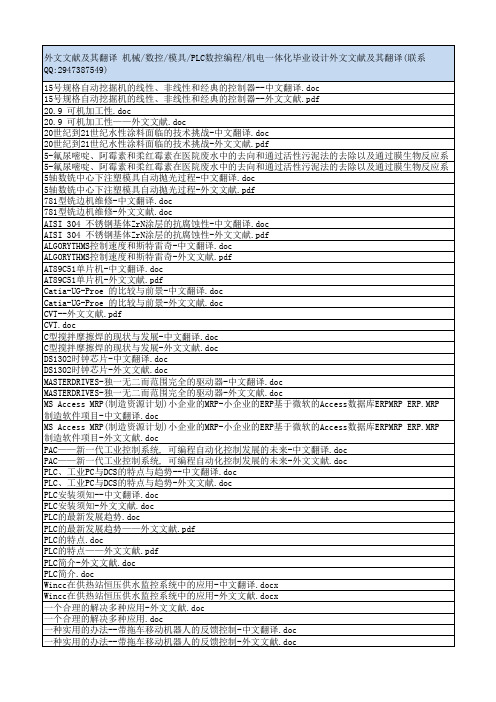
农业节水技术采用的决定因素:研究中国的10个省份--中文翻译.doc 农业节水技术采用的决定因素:研究中国的10个省份--外文文献.doc 冲压变形-中文翻译.docx 冲压变形-外文文献.doc 冲压模具设计中侧壁起皱的分析-中文翻译.doc 冲压模具设计中侧壁起皱的分析-外文文献.pdf 冷冲模具使用寿命的影响及对策-中文翻译.docx 冷冲模具使用寿命的影响及对策-外文文献.doc 凸轮设计的基本内容-中文翻译.docx 凸轮设计的基本内容-外文文献.doc 刀具成本的检测--外文文献.doc 刀具成本的检测文档.doc 切削加工新概念-中文翻译.docx 切削加工新概念-外文文献.docx 利用CAD - CAM - CAE软件及网络设施的产品开发-中文翻译.docx 利用CAD - CAM - CAE软件及网络设施的产品开发-外文文献.docx 利用三坐标测量仪确定聚苯乙烯材料表面形态--中文翻译.doc 利用三坐标测量仪确定聚苯乙烯材料表面形态--外文文献.doc 利用只装有车轮速度传感器的制动防抱死系统做路面情况鉴定-中文翻译.doc 利用只装有车轮速度传感器的制动防抱死系统做路面情况鉴定-外文文献.doc 利用曲臂3个自由度的相同并列式微型机械结构的实验设计-中文翻译.doc 利用曲臂3个自由度的相同并列式微型机械结构的实验设计-外文文献.doc 制造工程与技术(机加工)-中文翻译.doc 制造工程与技术(机加工)-外文文献.pdf 动态优化的一种新型高速,高精度的三自由度机械手-中文翻译.doc 动态优化的一种新型高速,高精度的三自由度机械手-外文文献.PDF 单刃刀具-中文翻译.doc 单刃刀具-外文文献.doc 单片机-中文翻译.doc 单片机-外文文献.pdf 单片机系统-中文翻译.doc 单片机系统-外文文献.doc 单片集成MEMS技术--中文翻译.doc 单片集成MEMS技术-外文文献.doc 压塑和压铸工艺-中文翻译.docx 压塑和压铸工艺-外文文献.docx 压电液压驱动器的设计和测试-中文翻译.docx 压电液压驱动器的设计和测试-外文文献.docx 原型基于颜色的图像检索与MATLAB -中文翻译.docx 原型基于颜色的图像检索与MATLAB -外文文献.docx 叠层陶瓷喷嘴的冲蚀磨损-中文翻译.doc 叠层陶瓷喷嘴的冲蚀磨损-外文文献.pdf 可伸缩悬臂式装煤机的研制--中文翻译.doc 可伸缩悬臂式装煤机的研制--外文文献.doc 可机加工性--中文翻译.doc 可机加工性--外文文献.doc 可编程控制器技术讨论与未来发展.doc 可编程控制器技术讨论与未来发展——外文文献.doc 可视化的PLC程序使用XML--中文翻译.doc 可视化的PLC程序使用XML——外文文献.doc 可靠性仿真与优化设计机械维修-中文翻译.docx 可靠性仿真与优化设计机械维修-外文文献.pdf 含有碳氮化合物的高压力钢应用于自动传动齿轮的发展-中文翻译.docx 含有碳氮化合物的高压力钢应用于自动传动齿轮的发展-外文文献.docx
专科机械类论文参考文献范例

专科机械类论文参考文献一、专科机械类论文期刊参考文献[1]专科机械类专业实践教学改革的分析与研究.《实验室研究与探索》.被北京大学《中文核心期刊要目总览》收录PKU.1999年6期.韩存仓.林士兰.[2].工程制图与机械基础系列课程改革的研究.《机械工业高教研究》.被南京大学《核心期刊目录》收录CSSCI.2002年4期.崔承琦.[3].专科层次机械类专业CAE课程教学内容研究与实践.《辽宁省交通高等专科学校学报》.2009年5期.高显宏.[4].吸引头类管腔器械机械清洗架的研制与使用.《中华护理杂志》.被中信所《中国科技期刊引证报告》收录ISTIC.被北京大学《中文核心期刊要目总览》收录PKU.2013年9期.刘启华.冷萍.[5].对高职高专机械类专科《液压传动与气动》课程的探索.《现代企业教育》.2008年20期.林晖.唐勰.[6].民办高校汽车专科专业机械制图教学探索.《产业与科技论坛》.2014年22期.杨娜.[7].高职机电与机械类本科专业课程衔接的研究.《广州航海学院学报》.2014年4期.唐振宇.刘志军.[8].SCL90量表使用的现状及检测心理健康的异议.《中国心理卫生杂志》.被中信所《中国科技期刊引证报告》收录ISTIC.被北京大学《中文核心期刊要目总览》收录PKU.被南京大学《核心期刊目录》收录CSSCI.2004年1期.王金道.[9].高职高专非机械类专业车工实训的教改与实践.《哈尔滨职业技术学院学报》.2014年5期.田野.王蕾.田金波.伊洺扬.[10].新疆高校少数民族学生在工科类课程学习中遇到的问题与改革建议. 《新疆农机化》.2015年1期.郭文松.范修文.周岭.二、专科机械类论文参考文献学位论文类[1].基于USB2.0高速接口的机床振动实验系统的开发.被引次数:2作者:曹雏清.机械设计及理论重庆大学2008(学位年度)[2].小波分析在往复机械特征提取中的应用研究.被引次数:9作者:鞠培刚.机械电子工程大连理工大学2007(学位年度)[3]经济全球化进程中我国高等教育结构分析——劳动力市场视角.作者:白萌.高等教育学北京师范大学2011(学位年度)[4].角膜神经痛的临床研究.作者:李一敏.眼科学复旦大学2012(学位年度)[5].口腔CT控制系统的设计.作者:骆毅斌.生物医学工程南方医科大学2013(学位年度)[6].近代方剂学成就与特点研究(18401949).作者:黄鑫.中医医史文献中国中医研究院中国中医科学院2005(学位年度)[7].牙槽骨维度不足的口腔种植临床研究(附36例报告).作者:石全贵.口腔临床医学大连医科大学2010(学位年度)[8]. 高等学历教育学生自我导向学习研究.被引次数:4作者:李攀. 教育学四川师范大学2012(学位年度)[9].ICU高年资医生非工作日值班对重症脓毒症/脓毒性休克患者预后的影响.被引次数:1作者:周建仓.内科学(传染病学);脓毒症浙江大学2013(学位年度)[10].OSAHS患者腭咽肌纤维改变及myogenin、myostatin的表达和临床意义研究.作者:赵晨.临床医学;耳鼻咽喉科学中国医科大学2014(学位年度)三、专科机械类论文专著参考文献[1]加强我校省级机械基础实验教学示范中心的实验教学改革.王为.魏春梅.魏兵,2006第八届全国机械设计教学研讨会议暨见习机械师设计工程师工作会议[2]产学研结合培养机械制造类专业特色人才.成虹,2003第二次全国高职高专教育产学研结合经验交流会[3]日本胃肠动力实验技术及研究方法.张苏闽.2005年肛肠外科高层学术论坛[4]产学研结合建一流实训基地.陈传伟.曹凤.张世凭,2003第二次全国高职高专教育产学研结合经验交流会[5]面向轴类零件FMS四自由度直角坐标机器人的研制.吴建华.卜云峰.刘榜实,1998中国人工智能学会第三届智能机器人学术研讨会[6]基于竞赛驱动模式的师范院校电子专业学生创新能力的培养.龙兴明.马燕.郭世刚.宋培森,2009第六届全国高等学校电气工程及其自动化专业教学改革研讨会[7]小儿辅助循环新进展.丁文祥,2007第九届中国南方国际心血管病学术会议[8]旋转对称子结构罚单元分析.李香莲.李舜酩.方圣,2000中国兵工学会第10届测试技术研讨会[9]甘蓝生产现状及其机械化收获技术研究.王芬娥.郭维俊.曹新惠.韩正晟.魏宏安,2008中国农业机械学会2008年学术年会[10]工程图学课程实施创新教育的研究.顾寄南.黄燕萍.戴立玲,2002第十三届全国图学教育研讨会暨制图CAI课件演示交流会。
- 1、下载文档前请自行甄别文档内容的完整性,平台不提供额外的编辑、内容补充、找答案等附加服务。
- 2、"仅部分预览"的文档,不可在线预览部分如存在完整性等问题,可反馈申请退款(可完整预览的文档不适用该条件!)。
- 3、如文档侵犯您的权益,请联系客服反馈,我们会尽快为您处理(人工客服工作时间:9:00-18:30)。
1、‘‘How can a bill of materials be defined so that all possible products can be built efficiently?’’ One way to answer it is to define a set of components (called modules), each of which contains a set of primary functions. An individual product is then built by combining selected modules.
【1】Bruno Agard,Bernard Penz. A simulated annealing method based on a clustering approach to determine bills of materials for a large product family. Int. J. Production Economics 117 (2009) 389–401.
2、In this study, we propose a methodology for building a semantically annotated multi-faceted ontology for product family modelling that is able to automatically suggest semantically-related annotations based on the design and manufacturing repository.
【2】Soon Chong Johnson Lim,Ying Liu,Wing Bun Lee.A methodology for building a semantically annotated multi-faceted ontology for product family modelling. Advanced Engineering Informatics 25 (2011) 147–161.
3、The aim of this work is to establish a methodology for an effective work ing of Reconfigurable Manufacturing Systems (RMSs). These systems are the next step in manufacturing, allowing the production of any quantity of highly customised and complex products together with the benefits of mass production.
【3】R.Galan,J.Racero,I.Eguia,J.M.Garcia. A systematic approach for product families formation in Reconfigurable Manufacturing Systems.Robotics and Computer-Integrated Manufacturing 23 (2007) 489–502.
4、A mixed integer linear programming model is investigated that optimizes the operating cost of the resulting supply chain while choosing the product variants and can define the product family and its supply chain simultaneously.
【4】Jacques Lamothe,Khaled Hadj-Hamou,Michel Aldanondo. An optimization model for selecting a product family and designing its supply chain. European Journal of Operational Research 169 (2006) 1030–1047.
5、This paper presents LCP-families, a concept to develop reference ranges for environmental impact of a new product. A new product can be catalogued as environmentally better or worse than a percentage of its competitors, depending on what position it occupies in its LCP-family.
【5】Daniel Collado-Ruiz,Hesamedin Ostad-Ahmad-Ghorabi. Comparing LCA results out of competing products: developing reference ranges from a product family approach. Journal of Cleaner Production 18 (2010) 355–364.
6、This paper has proposed a cooperative coevolutionary optimization method for optimal design of product family with multi–level commonality .
【6】L.Schulze,L.Li. Cooperative Coevolutionary Optimization Method for Product Family Design.
7、This paper characterizes a decision framework by which a firm can manage generational product replacements under stochastic technological changes.
【7】Heng Liu,Ozalp Ozer. Managing a product family under stochastic technological changes. Int. J. Production Economics 122 (2009) 567–580.
8、This paper proposes an information search and retrieval framework based on the semantically annotated multi-facet product family ontology to save time for the ontology development in design engineering.
【8】Soon Chong Johnson Lim,Ying Liu,Wing Bun Lee. Multi-facet product information search and retrieval using semantically annotated product family ontology. Information Processing and Management 46 (2010) 479–493.
9、The purpose of the paper is to present Product V ariety Analysis (PVA) approach to coordinated and synchronized fows of information about products and production processes among various supply chain members.【9】Petri Helo,Qianli Xu,Kristianto,Roger Jianxin Jiao. Product Family Design And Logistics Decision Support System.
10、The purpose of this paper is to propose a product family design architecture that satisfies customer requirements with minimal efforts.【10】Taioun Kim,Hae Kyung Lee,Eun Mi Y oun. Product Family Design based on Analytic Network Process.
11、This paper presents a conceptual framework of using semantic annotation for ontology based decision support in product family design.
【11】Soon Chong Johnson Lim,Ying Liu,Wing Bun Lee. Using Semantic Annotation for Ontology Based Decision Support in Product Family Design。
